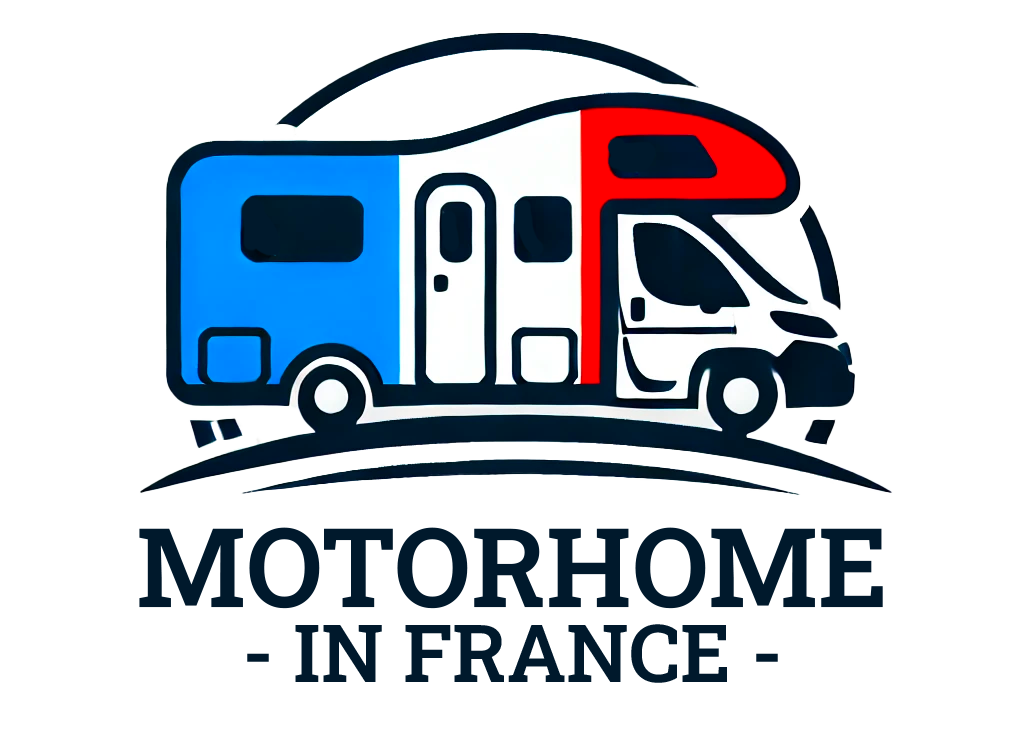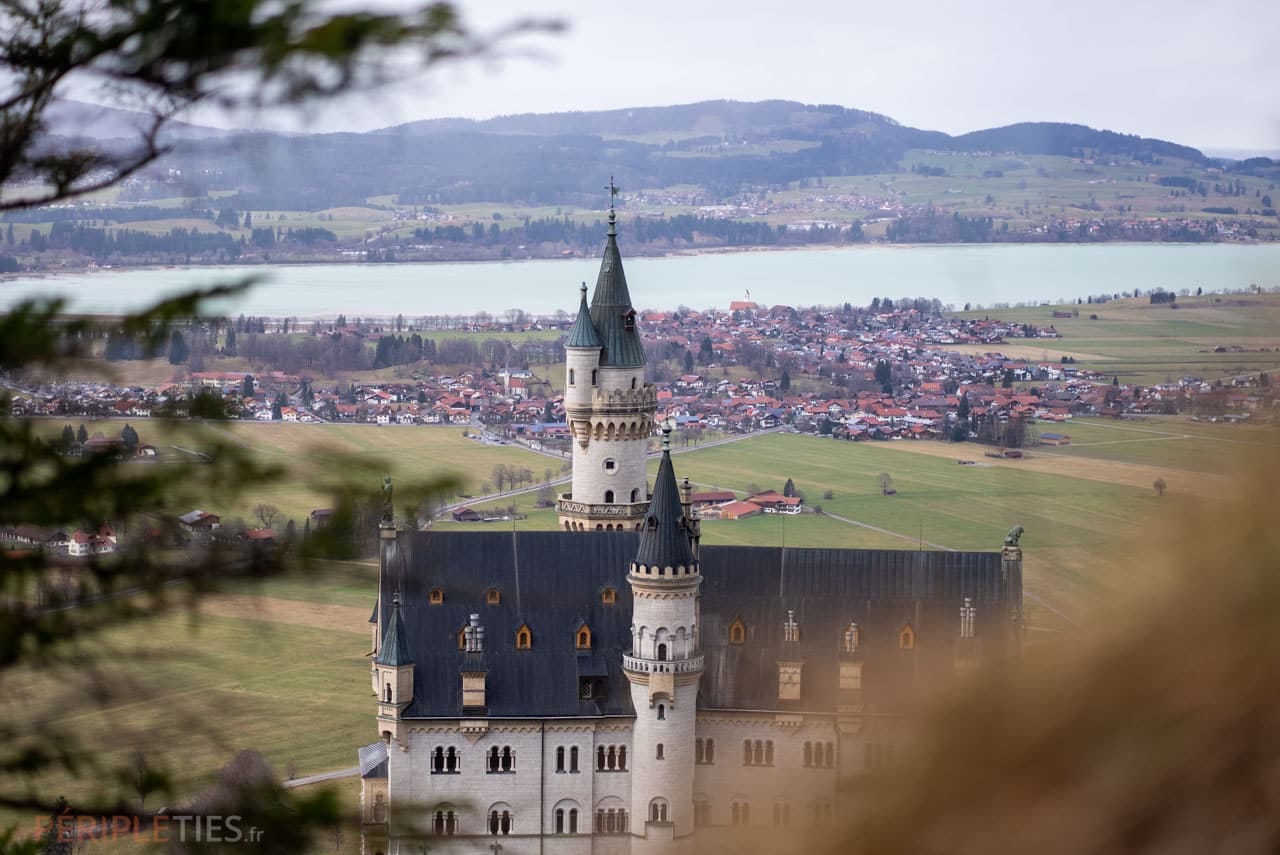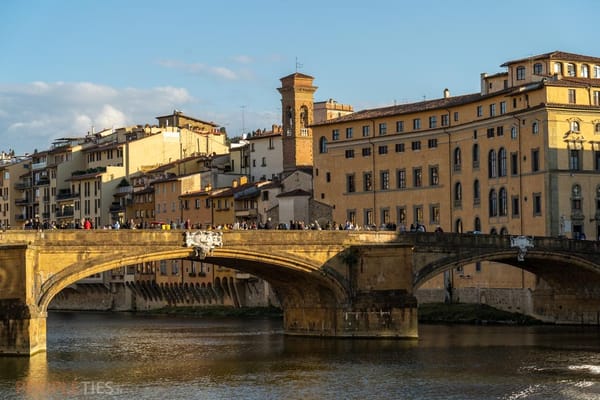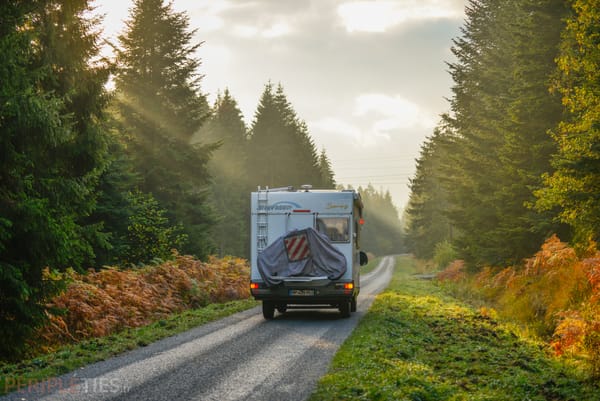One-week trip to Bavaria
This time we're opting for a road trip by car rather than by motorhome!
However, I'd like to reassure aficionados of road-trips in recreational vehicles straight away: this itinerary is perfectly adaptable to motorhomes and vans. We'll be providing information on the parking options available.
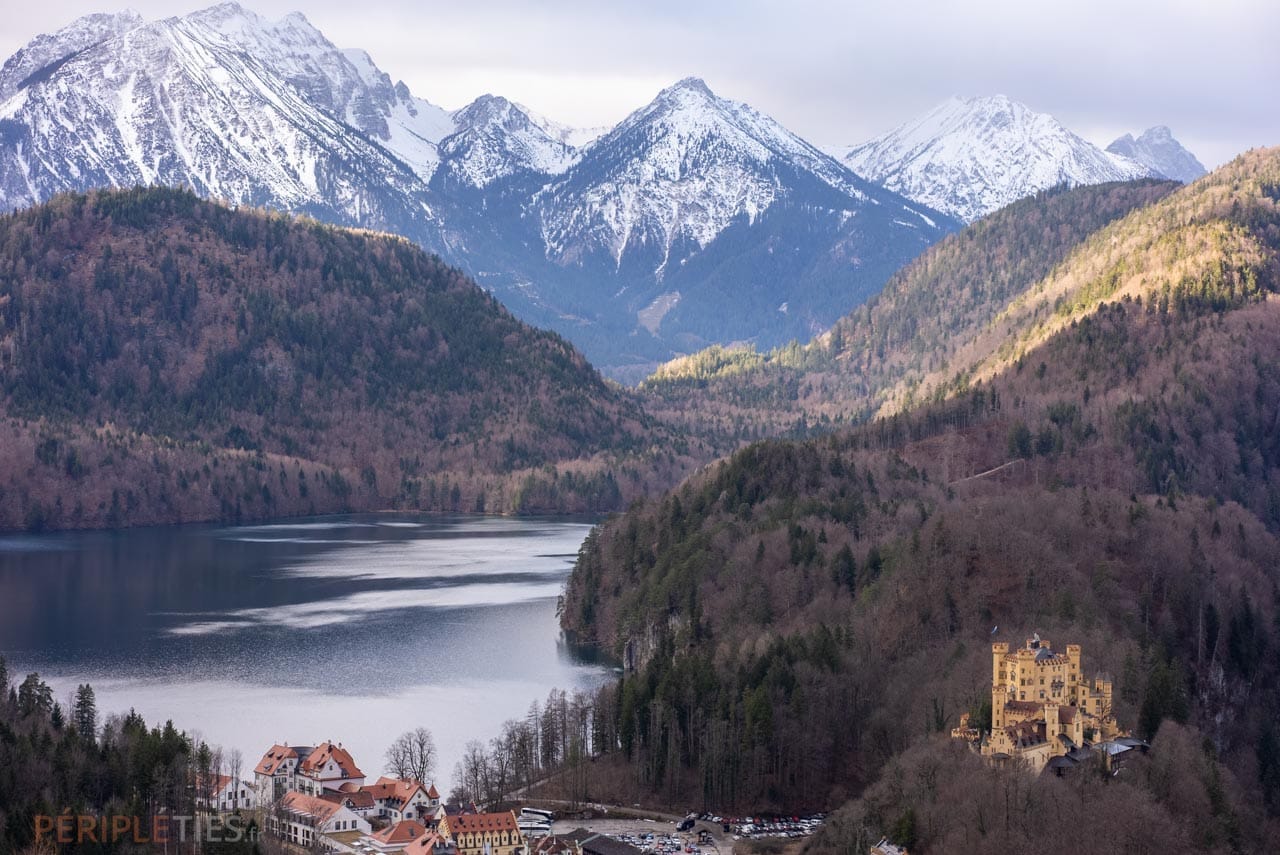
Heading for southern Germany
This one-week itinerary is a quick way to discover the enchanting charms of Bavaria, in the south of Germany. It's an excellent introduction to this picturesque region, which will certainly make you want to come back and explore even more of its hidden wonders...
Our route map by car: 7 days in Bavaria (500 km)
Why go to Bavaria?
Well, Germany is often underestimated as a tourist destination. But it's definitely a warm and welcoming country, where you immediately feel at home.
During our trip, we discovered a multitude of castles and cloisters, which are not the sole preserve of Bavaria.
However, this region stands out as the perfect starting point for exploring Germany's rich culture and history.
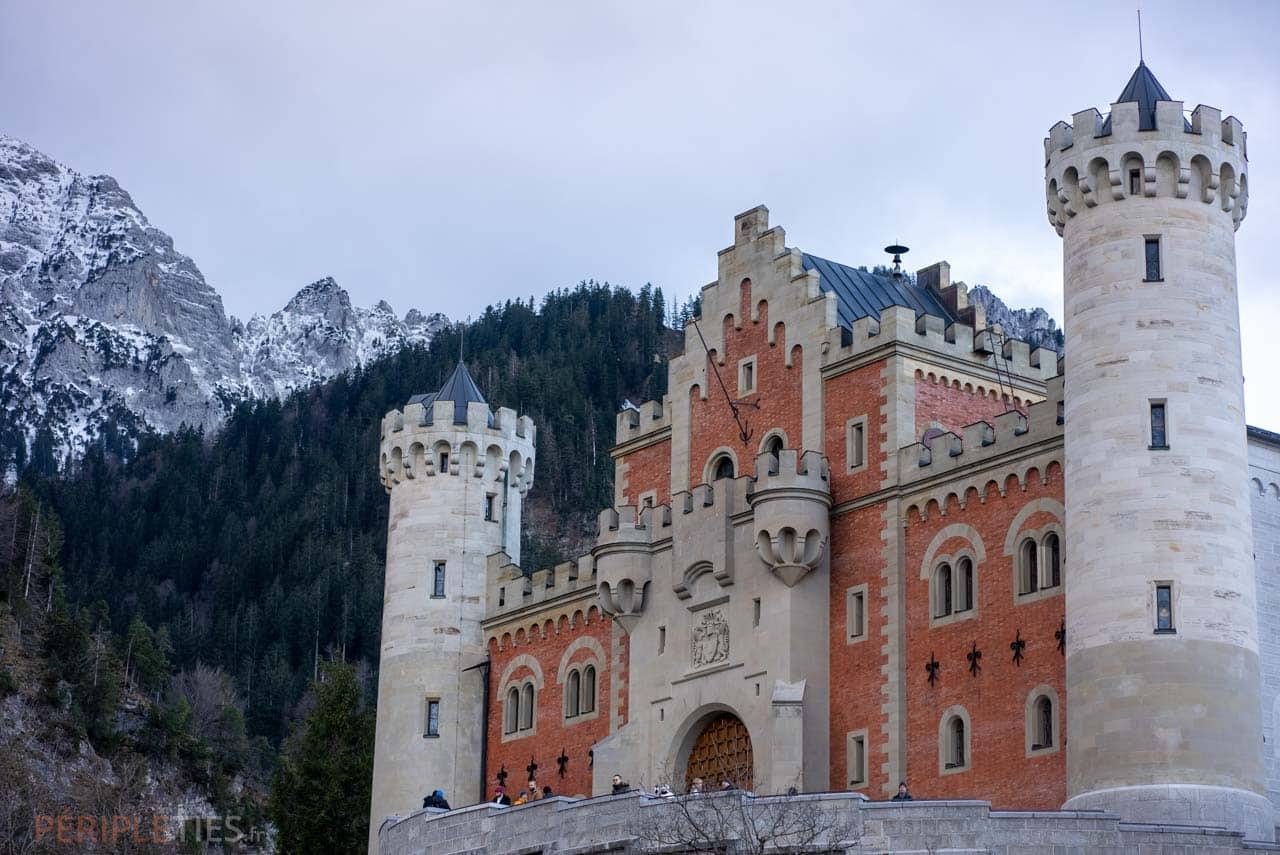
Tourism and places to visit in Bavaria
When you think of Bavaria, images of majestic castles immediately spring to mind. But there's much more to discover: the region also boasts an impressive landscape.
As you approach the Austrian border, the majestic Alps rise up, creating a spectacular panorama! And beyond its landscape, Bavaria is a breeding ground for lively customs and traditions that invite curiosity.
Tracht’, the traditional costumes worn with pride at local festivals, are not the only witnesses to these traditions...
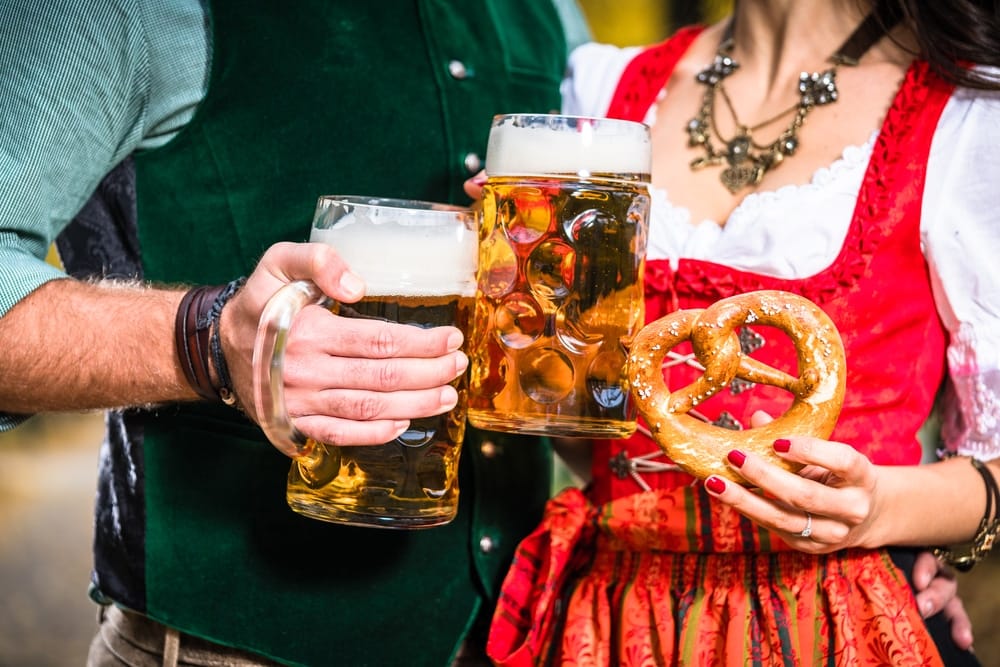
Living customs and traditions
During our roadtrip through Southern Bavaria, we were fascinated by the abundance of traditions and customs in Bavaria, the significance of which we didn't immediately realise.
What are those totem poles at the entrances to villages?
One intriguing example is the Maibaum, or May Tree, found at village entrances. These imposing wooden ‘totems’, decorated with religious or historical motifs or linked to local trades, symbolise the pride and identity of the communities, and are sometimes the object of rivalry between villages!
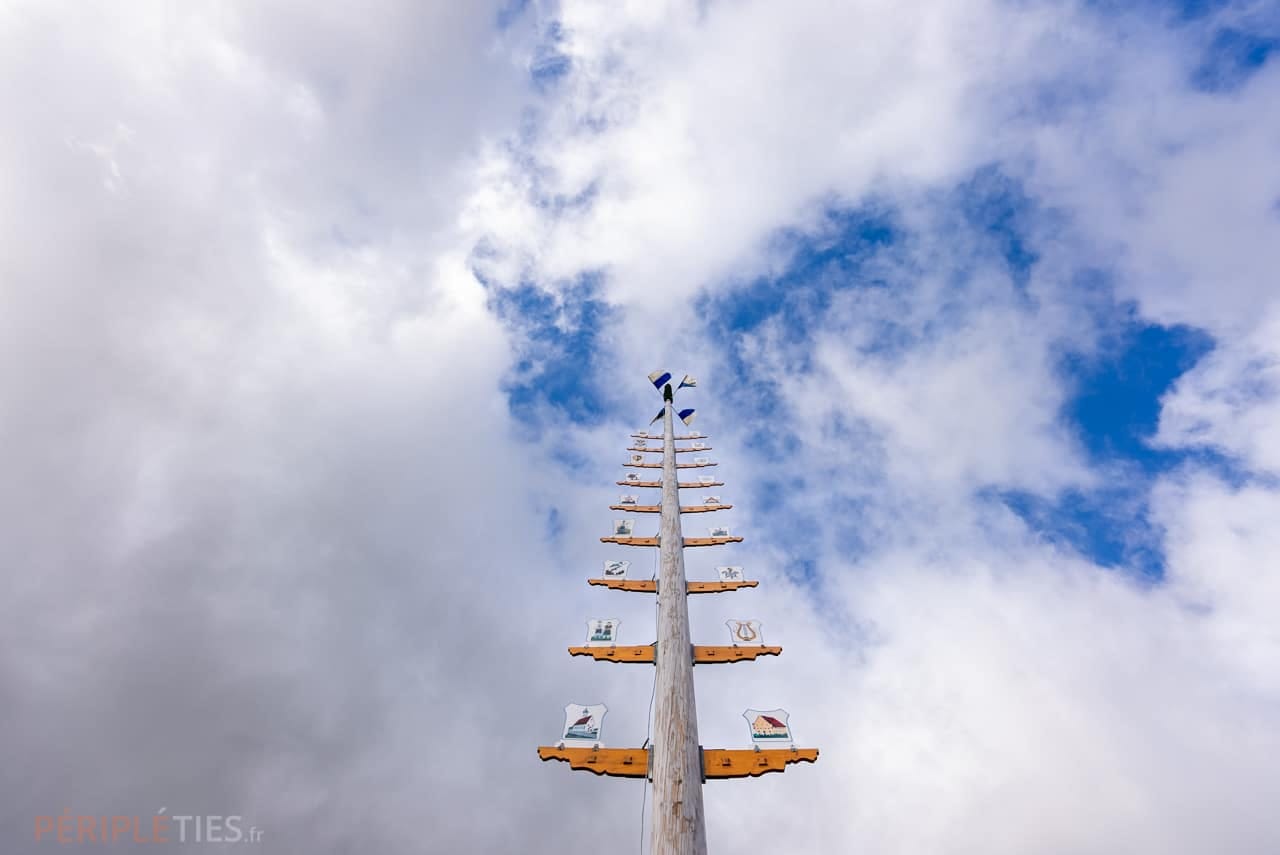
Christmas traditions
Other signs of deeply rooted traditions at Christmas time are the Christmas markets, of course, but also the Stars of Bethlehem that light up the entrances to houses.
Another custom that has been spotted here and there is the marking of houses with the letters C+M+B and a date. These initials represent the names of the three Magi or the blessing ‘Christus Mansionem Benedicat’. They are affixed by children, the ‘Sternsinger’, who sing from door to door to collect donations for charity on Epiphany.
Oktoberfest celebrations
But local Bavarian culture reaches its peak during the famous Oktoberfest, a traditional festival that runs from the end of September to the first week of October.
This popular celebration attracts millions of visitors from all over the world to share a moment of conviviality, celebrate Bavarian culture and, of course, enjoy a glass of beer. So even though it's fun, we still prefer Belgian beer!
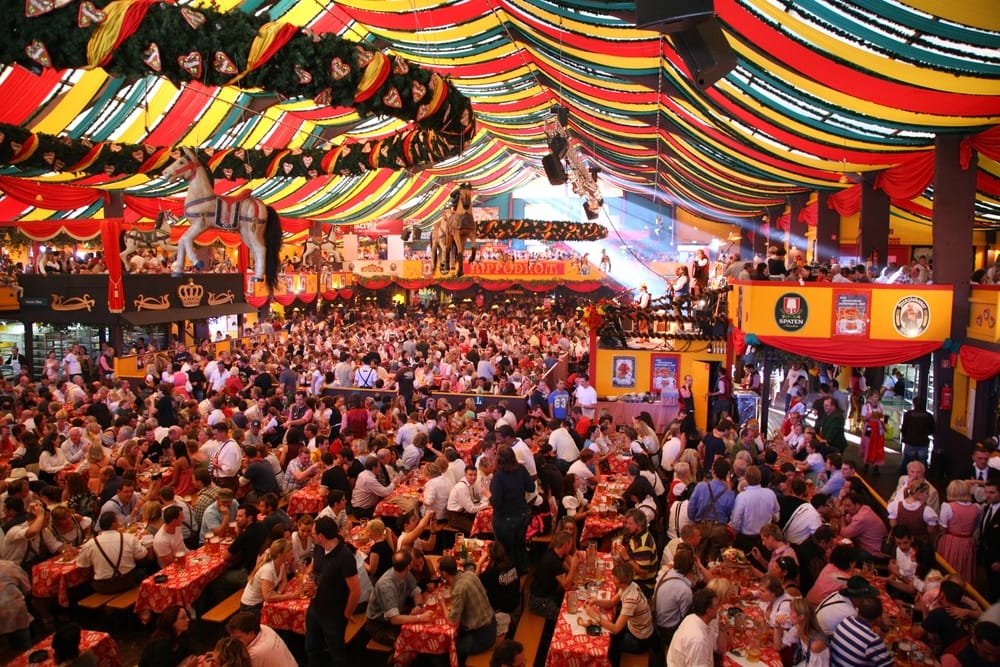
When should you go to Bavaria?
You can visit Bavaria all year round. If you like summer outdoor activities and festivals, summer is ideal. If you prefer milder temperatures and autumn landscapes, autumn is a good option. For Christmas markets and winter sports, Bavaria is ideal for the nearby Alps and ski resorts. Spring offers a balance between pleasant weather and fewer crowds.
Winter in Bavaria: Christmas Market and New Year in Munich
For this first excursion, we were in Bavaria during the New Year period. Discovering this region at this time of year adds a special dimension, with its unique festive atmosphere and the spectacular fireworks displays throughout the city, particularly along the banks of the River Isar.
Unfortunately, we arrived just too late for a visit to Munich's Christmas markets.
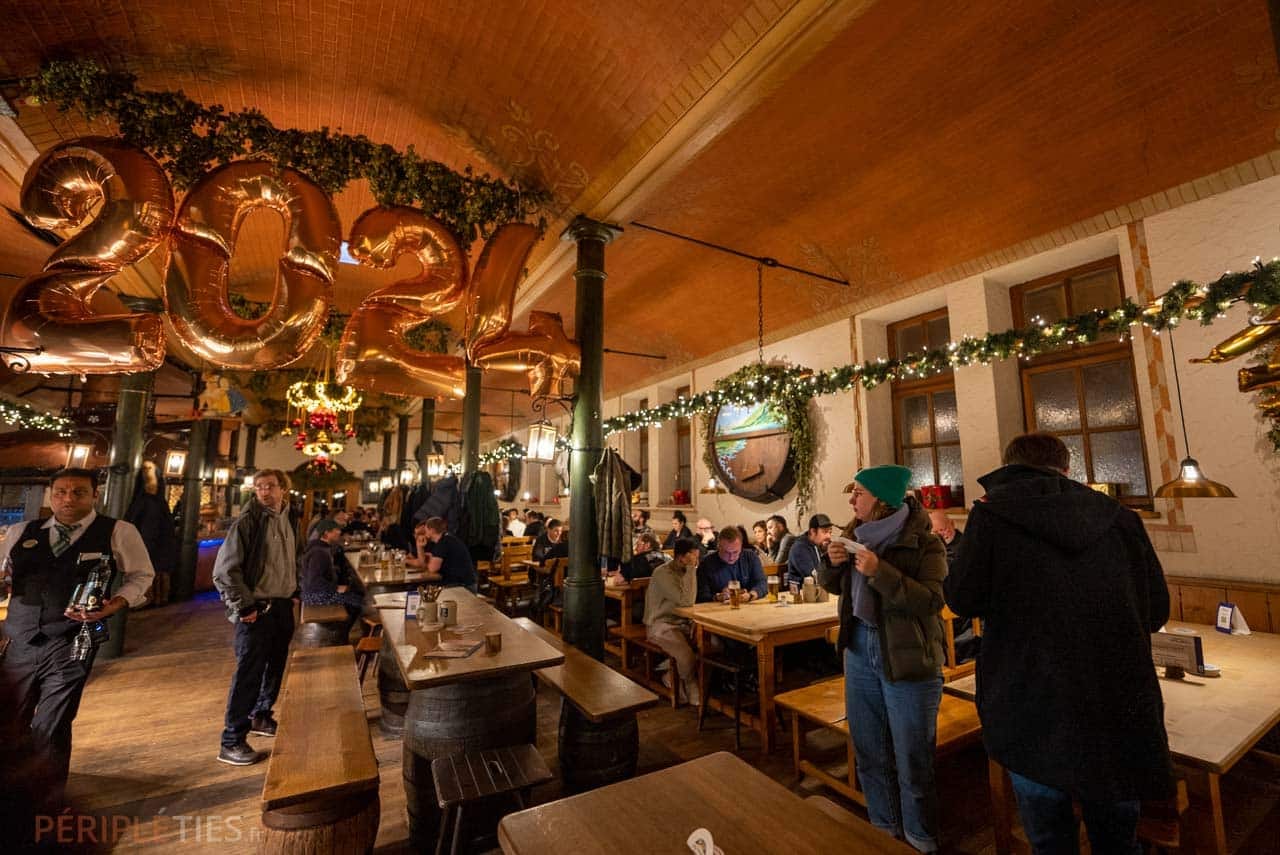
Days 1 and 2: Start of the roadtrip in Munich, capital of Bayern
Our roadtrip began in Munich, the capital of Bavaria. During our stay, we chose to stay on the outskirts, in the Laim district to be precise, at the WunderLocke hotel residence in Sendling.
Quite a change from our usual motorhome trips! This option offered a number of advantages.
Our opinion of the WunderLocke hotel in Munich
First of all, the area has plenty of parking spaces, which proved very practical, the underground and train are less than 5 minutes away on foot, and the establishment has a swimming pool, sauna, gym, bar-restaurant and rooftop on site!
What's more, it's located outside Germany's ‘Umweltzone’ low-emission zone.
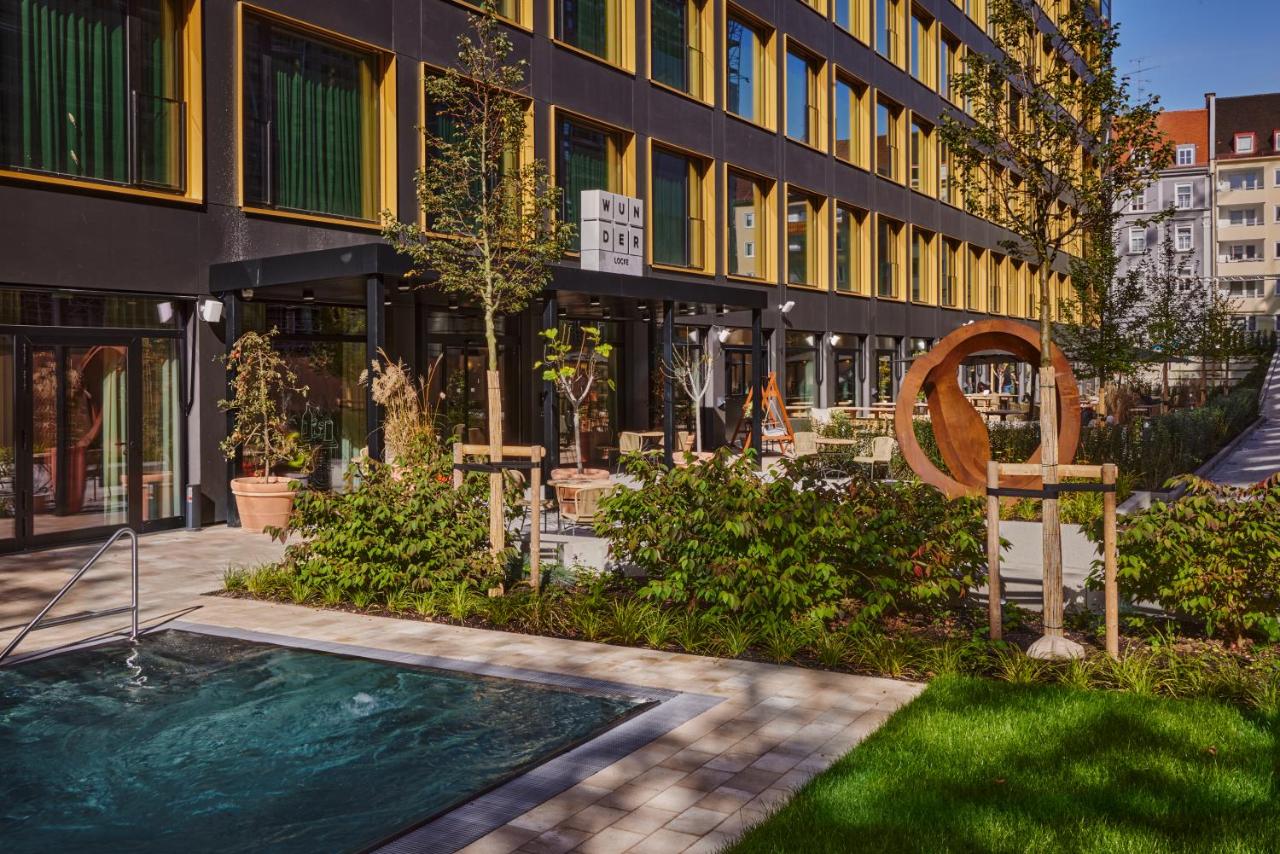
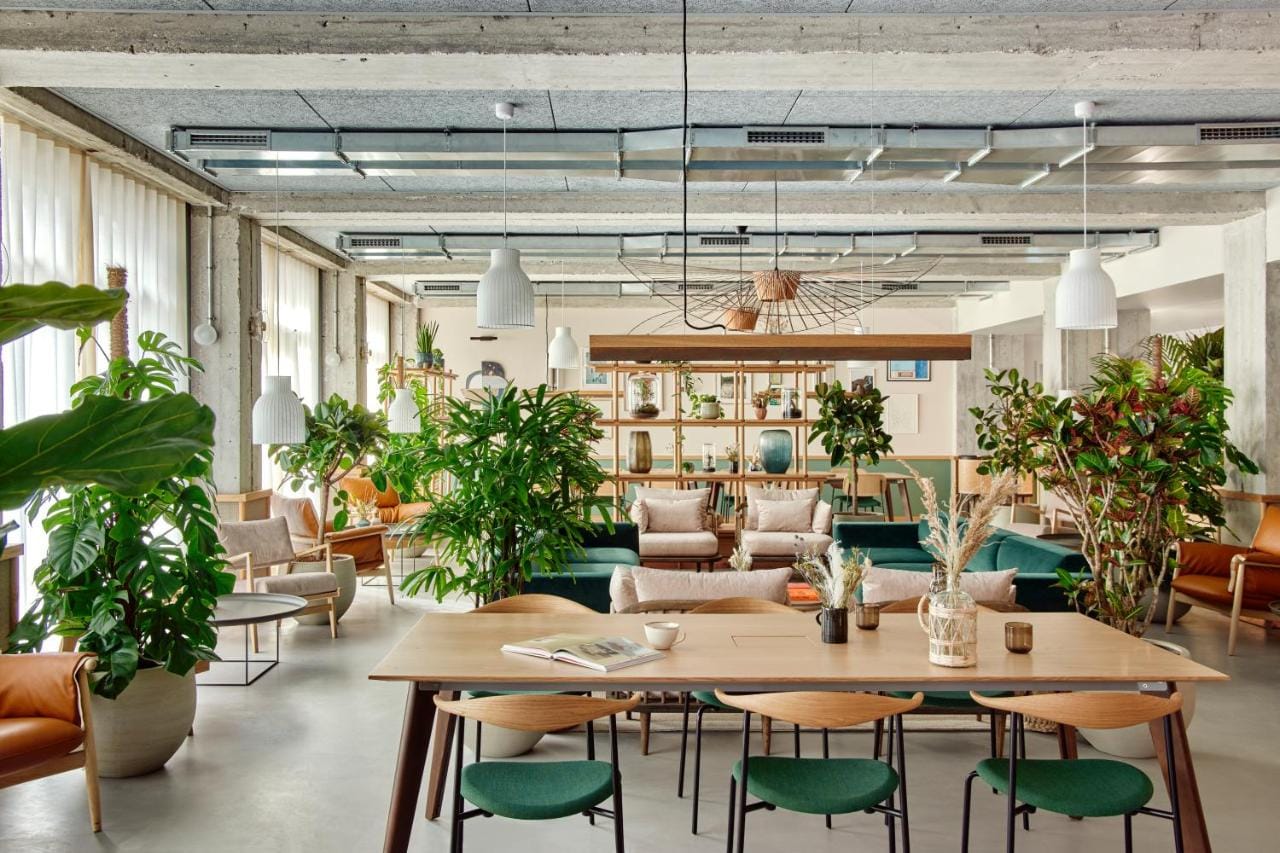
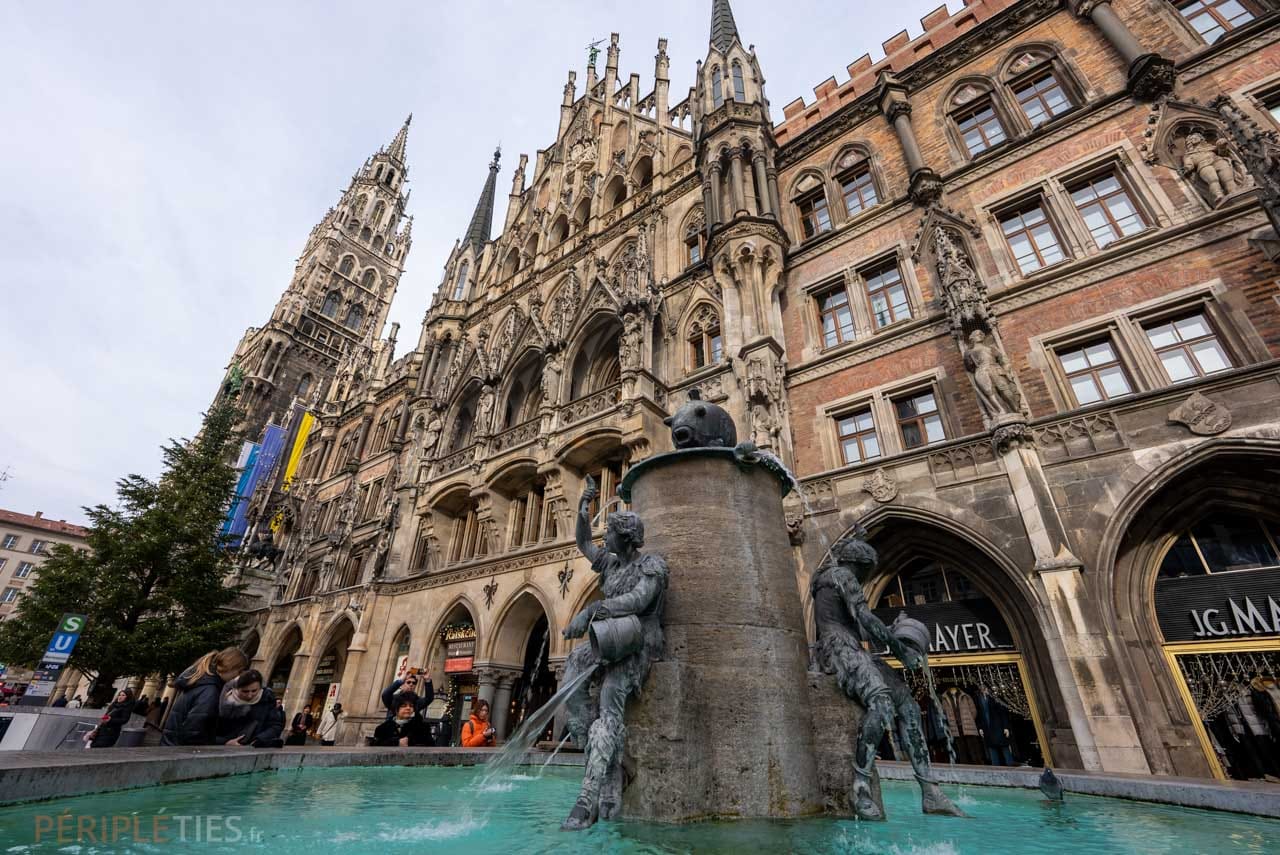
The underground: an easy way to get around Munich
We chose to take the underground, a particularly efficient means of transport in Munich, to get us quickly to Marienplatz, Munich's central square.
Once there, we had the pleasure of admiring the impressive architecture of the old town hall, as well as the famous Glockenspiel clock, one of the city's most emblematic attractions.
What are the differences between the Munich City Pass and the Munich City Card?
The Munich City Pass offers unlimited access to public transport (U-Bahn underground, S-Bahn train, bus, etc.). It includes free admission to 45 of Munich's museums and castles: Deutsches Museum, Jewish Museum, Pinakothek, FC Bayern Museum, Aquarium, etc. Reductions or reduced rates are also available for certain guided tours, shows, and at commercial partners, bars and restaurants. The pass is valid for 2, 3 or 4 days, and costs from €56.90. A must if you're planning to visit Munich for a weekend. Given that the price of an underground ticket is already €3.90 per journey and a visit costs around €10, it will quickly pay for itself!
The Munich City Card costs less (around €18 and from €5.90 without transport) and includes transport, but no free entry, just discounts.
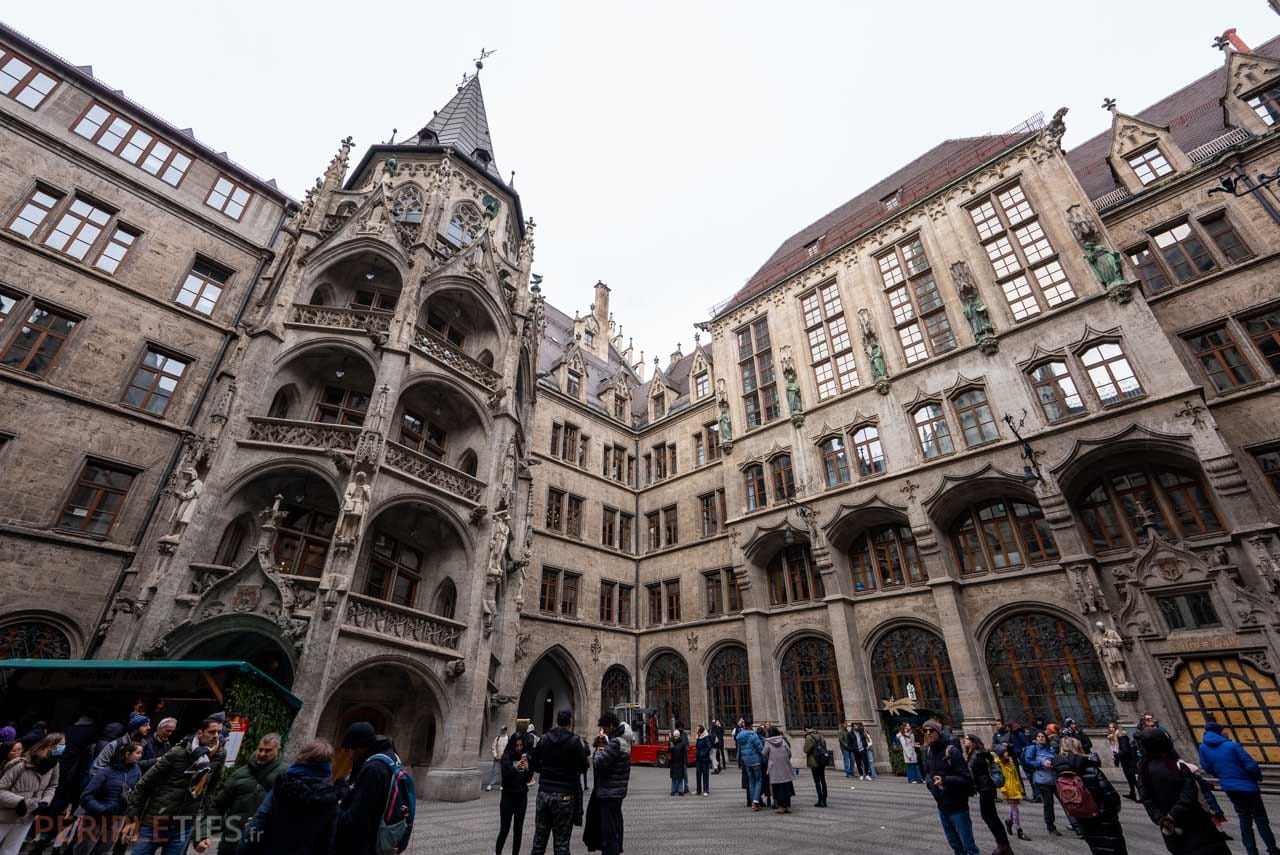
Visit Munich, Bavaria's largest city
Munich is Bavaria's largest city. We explored the old town on a tour suggested in Lonely Planet's Munich and Bavaria guide to discover the main attractions.
The Frauenkirche, a magnificent example of Gothic architecture, St Peter's Church, the Viktualienmarkt, the vibrant market square, and Hofbräuhaus, one of Munich's most famous breweries.
A free tour with a guide
Our walk also took us to the Fünf Höfe, a prestigious shopping complex, and then on to the English Gardens.
To visit Munich city centre in the company of an English-speaking guide, we recommend this free tour (2h30).
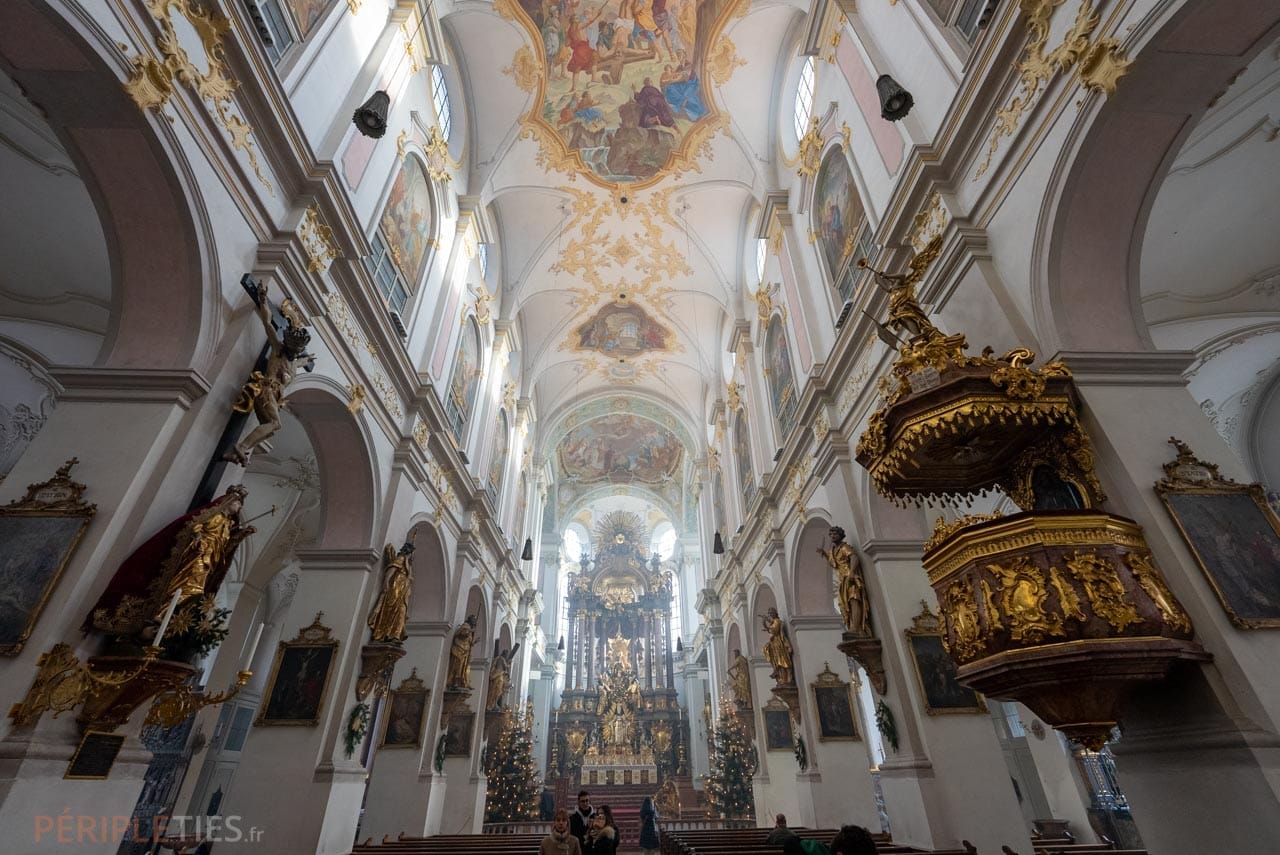
Eisbachwelle, the surfers' challenge
At the entrance to the Englischer Garten, there's an unusual attraction to say the least. Throughout the year, surfers take up the Eisbachwelle challenge.
To give you an idea, these surfers take advantage of an artificial wave formed by the currents of the Isar, the river that meanders through the city. This creates a unique opportunity to surf right in the heart of the city!
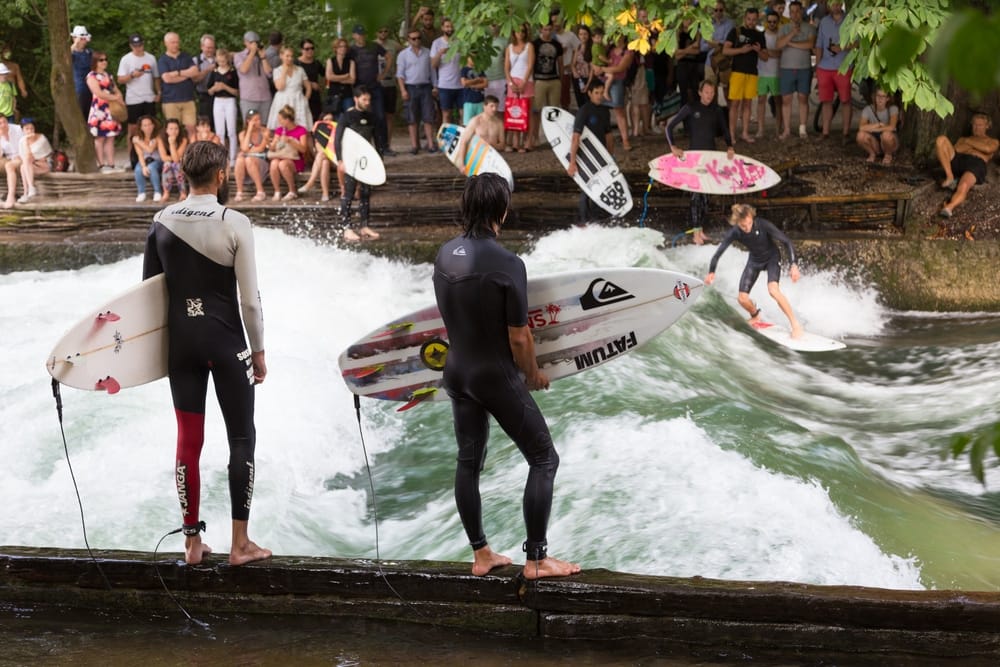
What to see and do in Munich? 5 ideas for activities
- A visit to the Viktualienmarkt with a tasting of Bavarian sausages (from €43)
- An evening of beer tasting and typical dishes (from €59)
- FC Bayern Munich Museum (from €12)
- A classical concert at Nymphenburg Castle (from €39)
- The Sea Life aquarium in Munich from €22
German gastronomy and local beers
You'll have the chance to sit down in one of the many taverns offering a selection of Bavarian specialities (Currywurst, Schnitzel and Spätzle, etc).
For those of you who'll be there at the same time as us! During the New Year period in Germany, shop opening times can be affected, with the majority of shops closing on 31 December due to the public holiday.
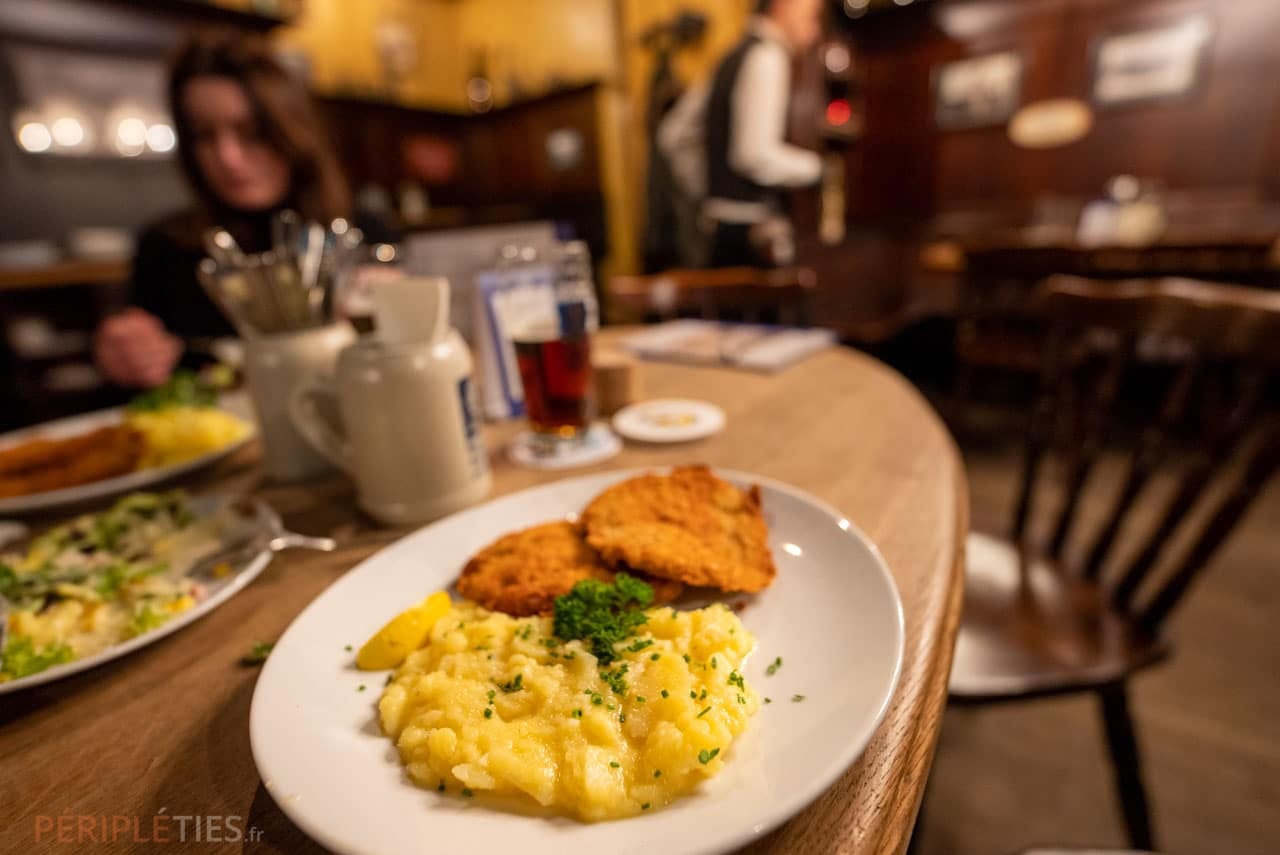
The Olympic Park, symbol of the 1976 Olympics
The following day, we took the metro to the Olympic Park. We particularly enjoyed visiting the former Olympic facilities.
The one that impressed us the most was undoubtedly that of the Winter Olympics in Sarajevo, but we have to admit that the Olympic Park in Munich, built for the 1972 Games, is also impressive and leaves no one indifferent!
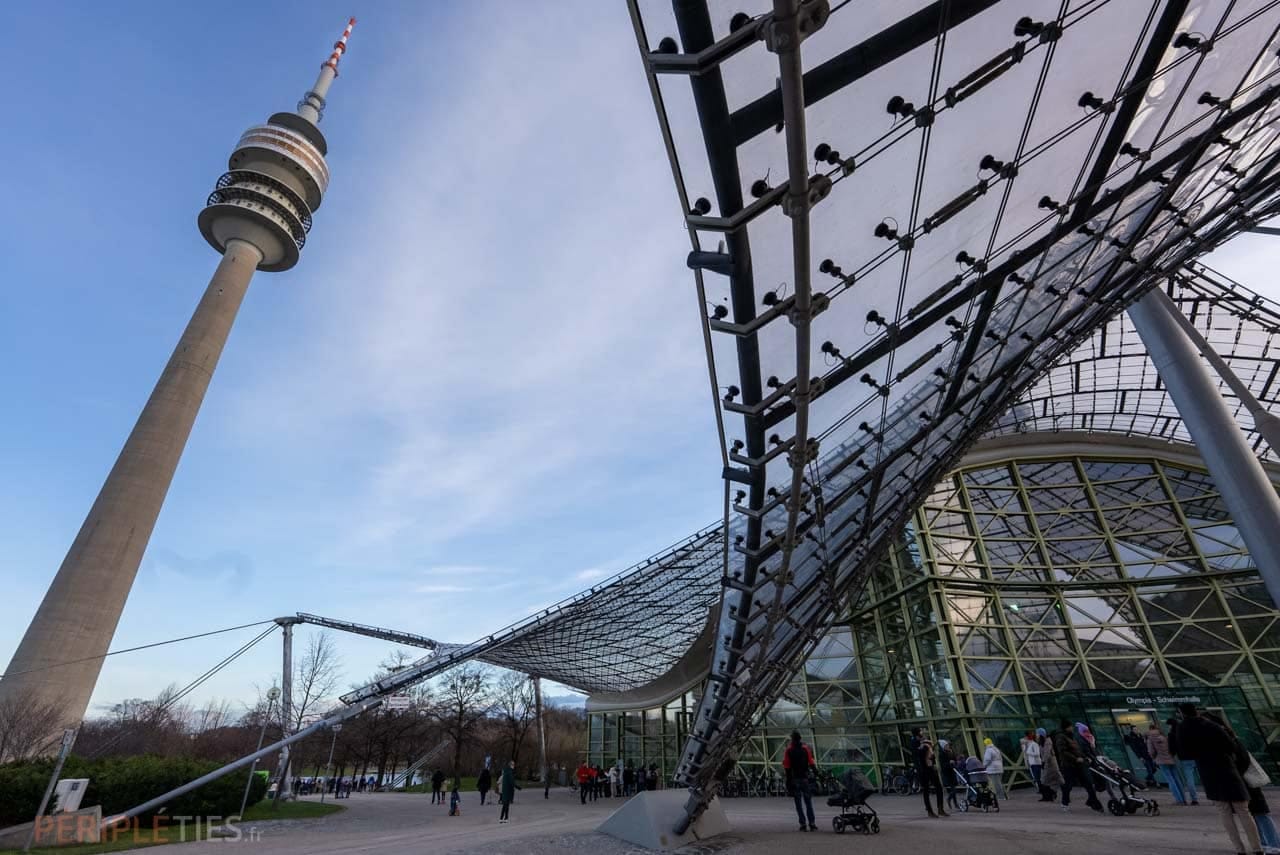
Located close to the BMW museum and headquarters (a popular spot for fans of big bikes, although our small group was not unanimous about this visit ^^), the Olympic Park is an emblematic place offering a unique fusion of modern architecture and nature. The Olympic Tower offers a breathtaking panoramic view (entry is free with the Munich City Pass).
The park itself, with its lush greenery, is ideal for relaxing and strolling, and the architecture of the athletics stadium is impressive (admission was €3.50 in early 2024).

But despite its Olympic dimension, the park is also associated with a historical tragedy.
The tragedy of the Munich Olympics
During the Games, a major tragedy took place, known as the Munich Massacre. On 5 September 1972, a Palestinian terrorist group called Black September took eleven members of the Israeli Olympic team hostage in the Olympic Village. This hostage-taking ended tragically with the death of all the Israeli hostages, as well as a West German policeman, an event that profoundly marked the history of the Olympic Games and led to major changes in the security of international sporting events.
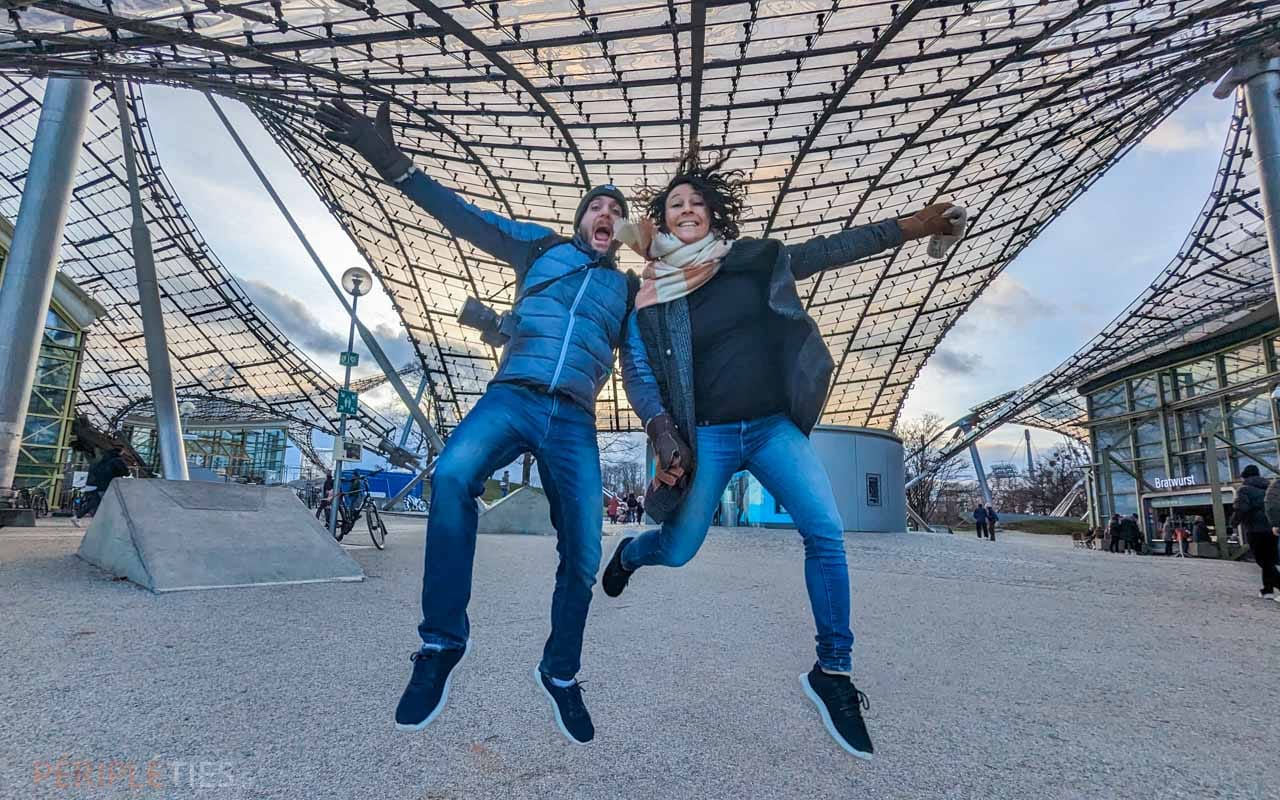
Where to go out and party in Munich?
With the New Year upon us, we've been looking for places to party. A word of warning: for a traditional celebration in a restaurant, it's advisable to book a hostel well in advance, as they tend to fill up quickly!
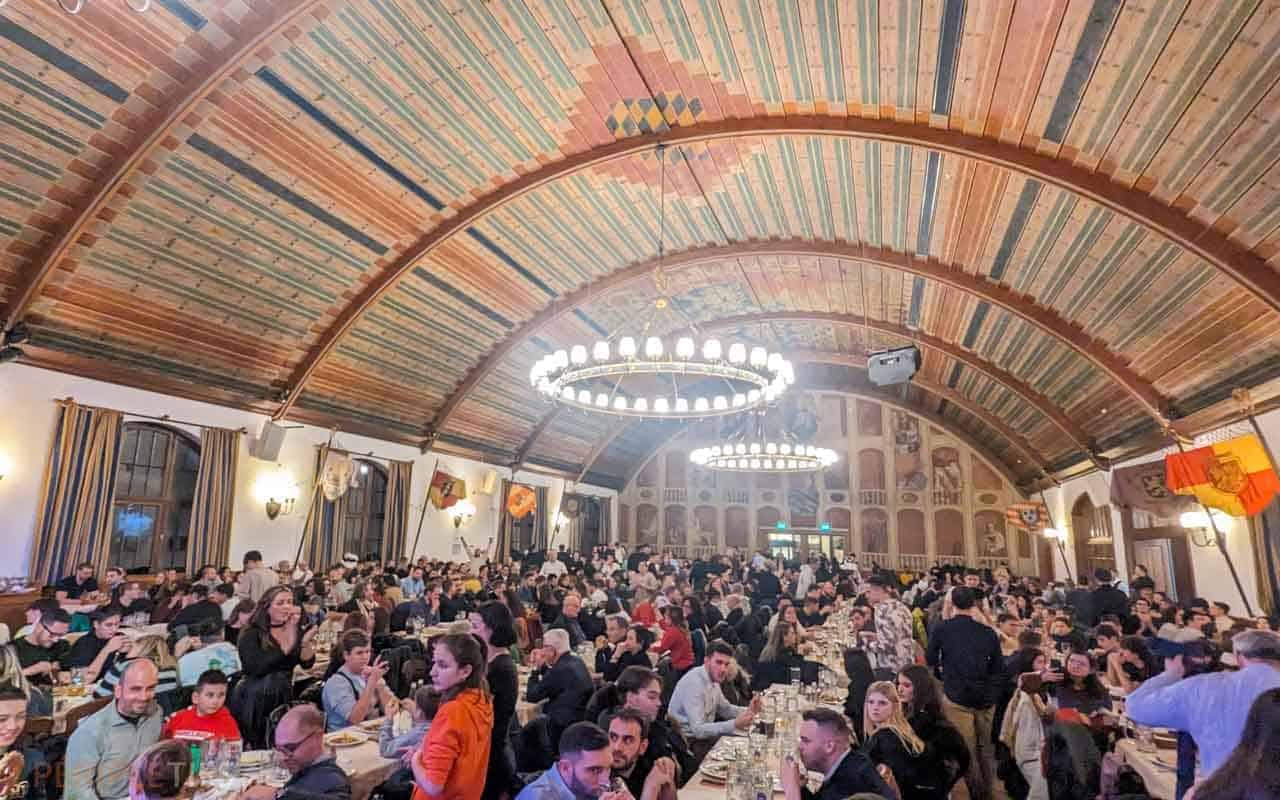
A typical Bavarian restaurant at the Hofbräuhaus or an alternative evening at the Backstage?
We've also got a few places to party all year round:
- Schwabing district: A bohemian district famous for its many bars, cafés and clubs. The atmosphere is relaxed and artistic.
- Leopoldstraße: A main street in Schwabing, with many bars and restaurants.
- Glockenbachviertel: This district is known as the heart of Munich's LGBT+ scene. Trendy bars and lively clubs.
- Hofbräuhaus: Munich's most famous brewery offering beer, Bavarian music and a festive, traditional atmosphere.
- Maxvorstadt: University district with bars and cafés frequented by students.
- Electronic music clubs: Munich has a vibrant electronic music scene, with clubs such as Harry Klein and Blitz.
We opted for the Backstage Kulturzentrum, an alternative venue with indoor spaces. Evenings and concerts by international rock bands, really fun!
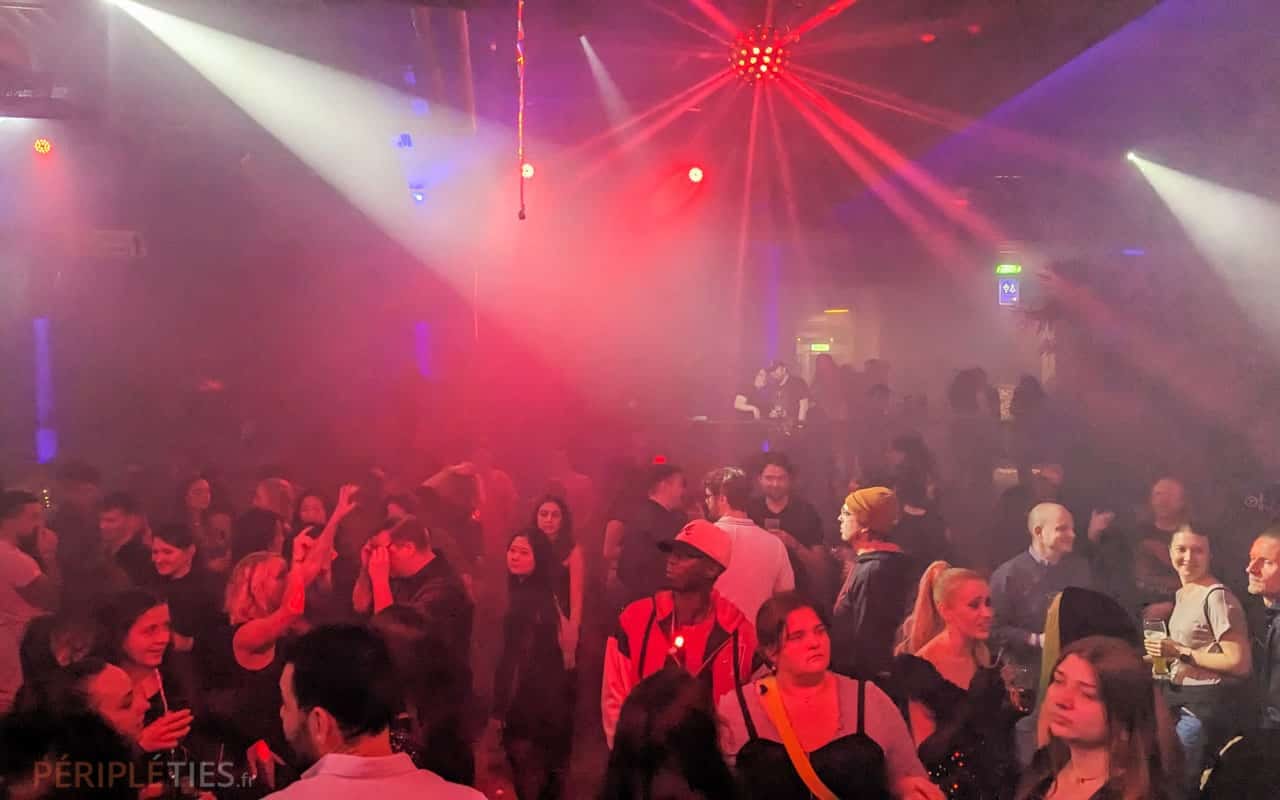
What to do around Munich: Our 5-day Bavaria tour
After a brief but intense exploration of Munich (our step counter was not idle!), we embarked on a five-day adventure through southern Bavaria.
Before I tell you about our road-trip in detail, you should know that if, unlike us, you didn't come with your own vehicle, you can rent a car in Munich.
Visit Nuremberg and Salzburg from Munich
Alternatively, you can also take a day trip from Munich. Here are 3 popular organised tours on offer :
- Day trip to Neuschwanstein and Linderhof Castle
- Half-day trip to the Dachau Memorial
- Day trip to Kehlsteinhaus (Hitler's Eagle's Nest)
- Day trip to Herrenchiemsee Castle
- Day trip to Salzburg
- Day trip to Nuremberg
- Excursion to Harburg Castle and Rothenburg
Should you visit Dachau, near Munich?
It's no secret that the town of Dachau, north of Munich, is historically linked to the presence of a former Nazi concentration camp. Today, it is a historic site and a memorial dedicated to the victims of the Holocaust and Nazi persecution.
Visiting this place is a personal decision, depending less on your interest in history than on your emotional state. We had already had the opportunity to visit Struthof, the only Nazi deportation camp in France, during our Alsace van road-trip, and Simon had also had the chance to visit Auschwitz-Birkenau in Poland.
This time round, we decided to follow my lead and keep things on a ‘humanly positive’ note. We still think that this kind of visit should be made at least once in your life, as a duty of remembrance.
Day 3: On the road to Bavaria's most beautiful villages
Our journey then takes us through picturesque, authentic villages, where traditional houses stand side by side with breathtaking scenery. Majestic mountains, a rich historical heritage ranging from ancient castles to centuries-old monasteries, lush forests and the famous Great Lakes of Bavaria.
The great Bavarian lakes
Among the best known are the Chiemsee, nicknamed the ‘Bavarian Sea’, Ammersee, Tegernsee, Königssee and Starnbergersee. These lakes offer wonderful settings for relaxing moments.
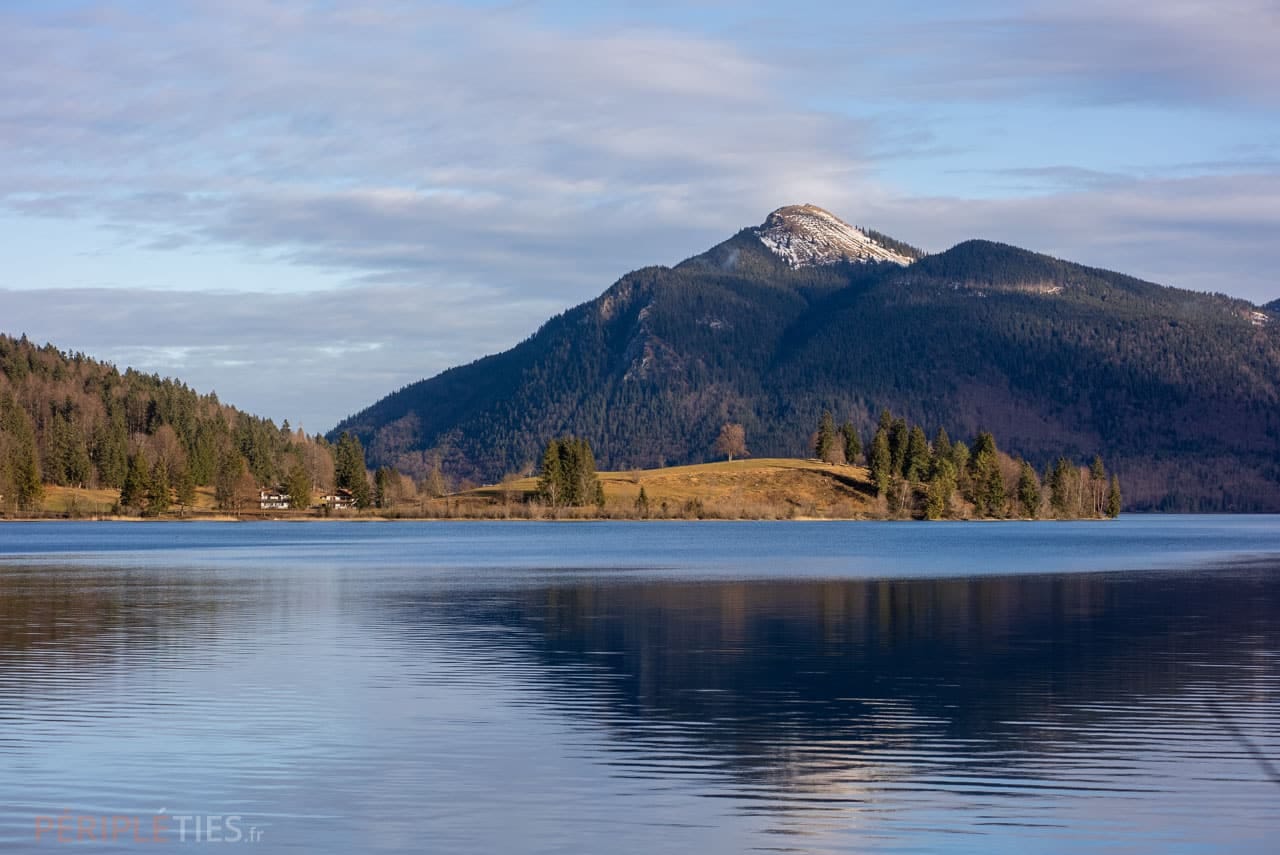
Around Lake Starnberg
Lake Starnberg lies on our route to Bad Tölz. The villages around the lake are among the most exclusive residential areas in the region.
Luxurious villas and magnificently renovated castles rise from the vast tree-lined lakefront estates. Nicknamed ‘Munich's bathtub’, the lake is a favourite spot for residents of Bavaria's capital seeking relaxation, swimming or water sports such as sailing and rowing.
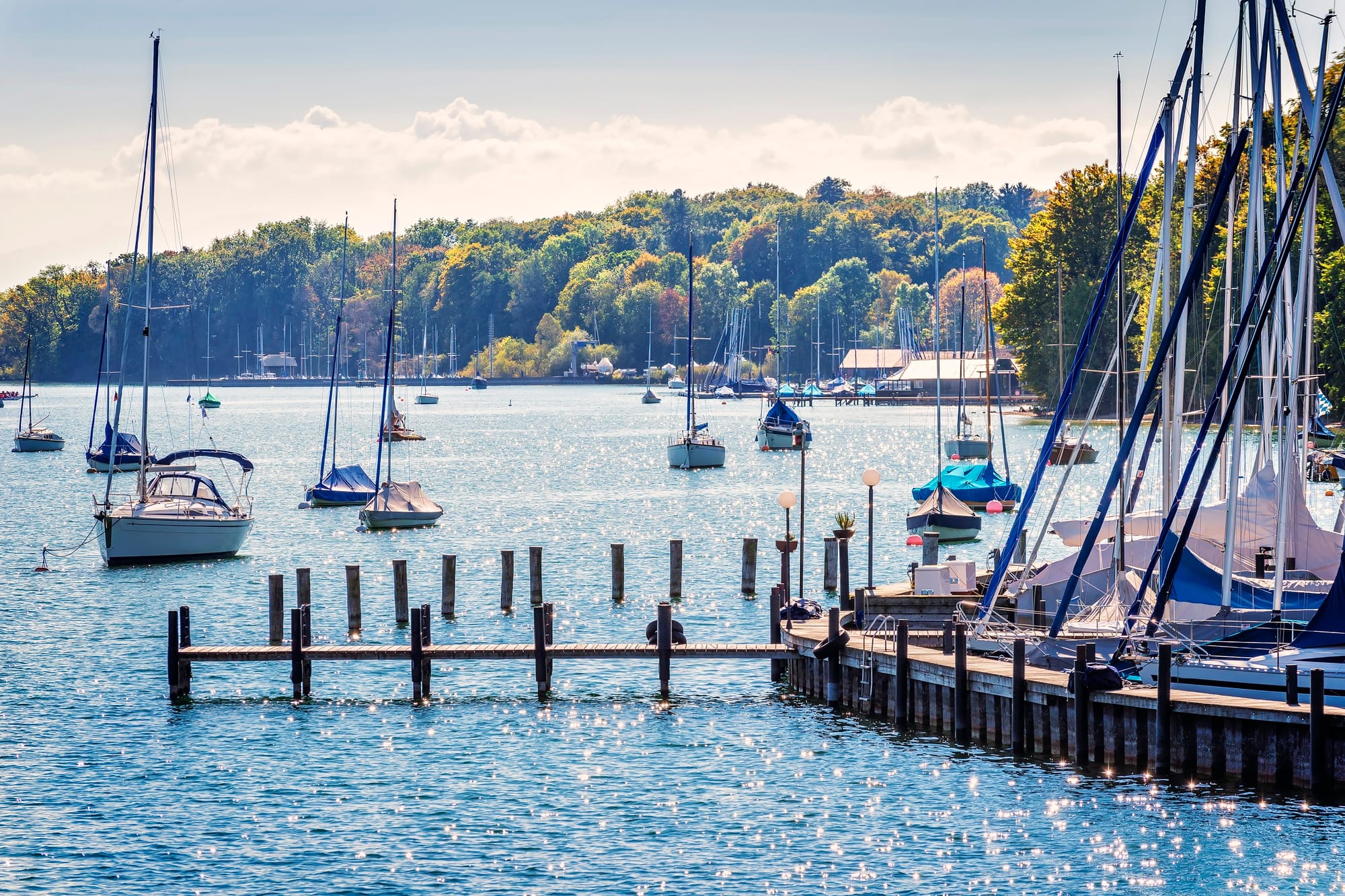
We didn't know it at the time, but Lake Starnberg is closely linked to the tragic fate of Bavaria's most legendary king, Ludwig II.
Indeed, it was on its shores that the king was found drowned in mysterious circumstances near the village of Berg in 1886.
And yes, it is with the end of his story that we begin our exploration of this fascinating region, closely linked to the King of Bavaria!
Ludwig II of Bavaria: the ‘mad king’?
Ludwig II of Bavaria is a fascinating historical figure. He acceded to the throne at the age of 18 and was known for his eccentric and introverted temperament. Although he showed little interest in politics, he left an indisputable legacy in Bavaria, including the famous Neuschwanstein castle. He also built other sumptuous palaces such as Linderhof Palace and Herrenchiemsee Palace, inspired by Versailles. His reign was marked by challenges, including the rise of the Prussian Empire, to which he had to pledge allegiance, which meant losing royal powers. His tragic end in 1886 (he was found drowned in Lake Starnberg), after being declared mentally unfit to reign, still gives rise to speculation and theories!
Stopover in Bad Tölz, a charming spa town
Nestling along the River Isar at the foot of the majestic Bavarian Alps, Bad Tölz is renowned for its picturesque town centre, with its richly decorated, colourful facades emblematic of Bavarian architecture.
Bad Tölz captivates visitors with its peaceful atmosphere, natural panoramas and relaxing thermal baths.
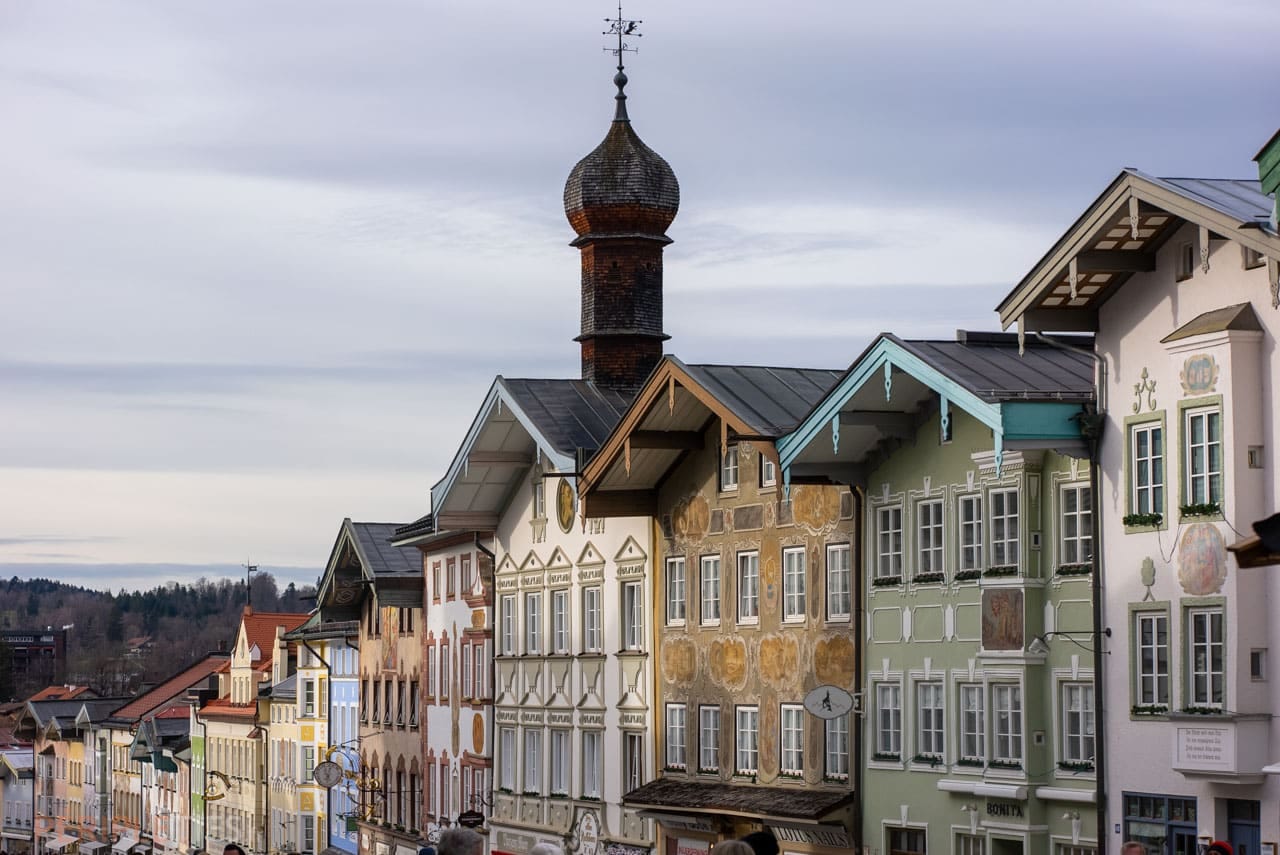
We enjoyed a short but delicious break for lunch in a charming traditional restaurant, the Tolzër Braüstüberl, perched high above the old town. Afterwards, we took a pleasant walk to explore different views of the city.’
Day 4: Garmisch-Partenkirchen and surrounding area
We then headed for Garmisch-Partenkirchen. The splendid road winds through the mountains alongside the Walchensee, one of Germany's deepest and largest alpine lakes.
The Zugspitze, Germany's highest mountain.
Once we reach a plateau, we take another spectacular route in the sunshine, which doesn't spoil anything. Even if, for the beginning of January, it's a bit hot!
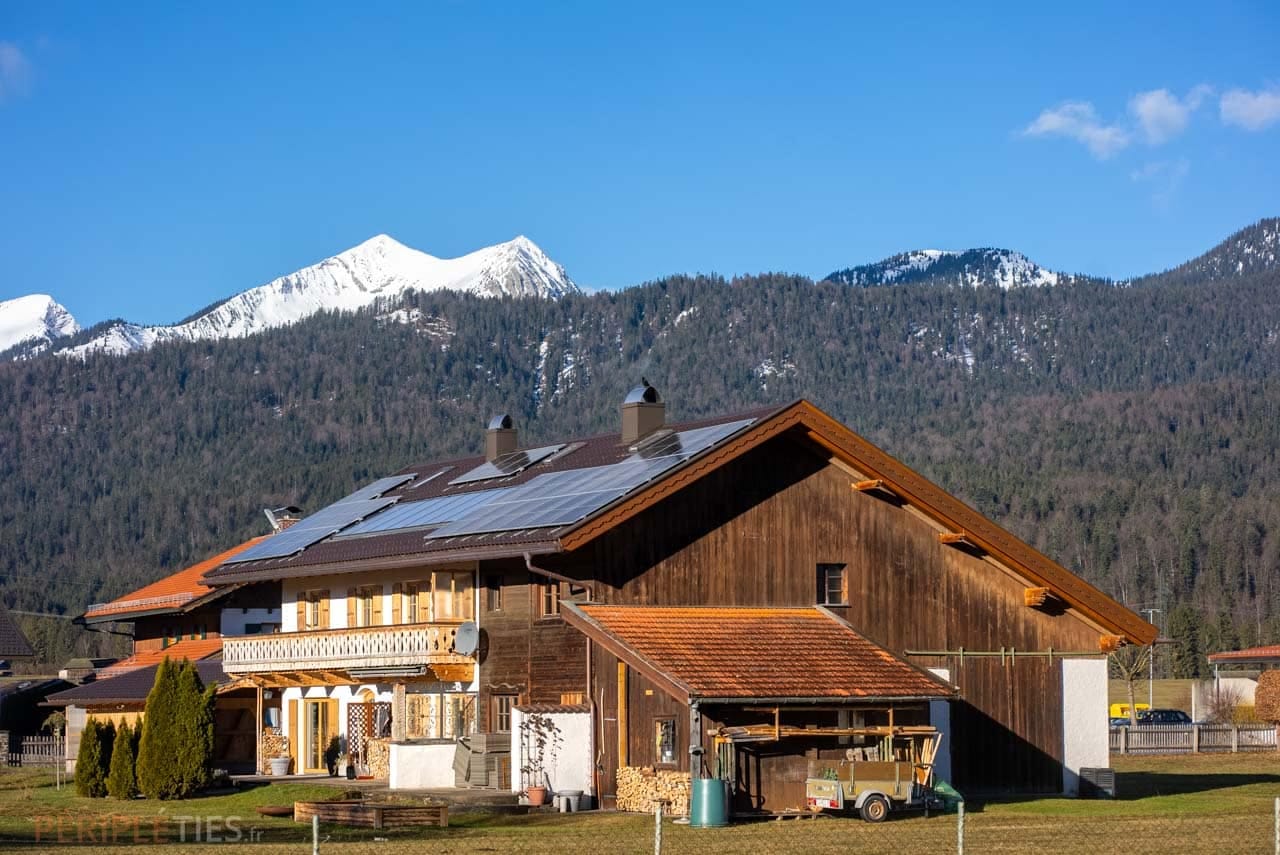
A few kilometres further on, we reach the resort of Garmisch-Partenkirchen, renowned for its spectacular mountain scenery, including the Zugspitze, Germany's highest peak.
This is a popular destination for winter sports and even hosted the 1936 Winter Olympics, although not the most glorious period in history. But never mind!
The surrounding area is steeped in Bavarian culture and is full of the region's must-see sites.
Hiking in the Partnach Gorge
We loved our hike in the Partnach Gorge (Partnachklamm in German), a canyon carved by thousands of years of river erosion, where the Partnach river cuts its way through dizzying walls...
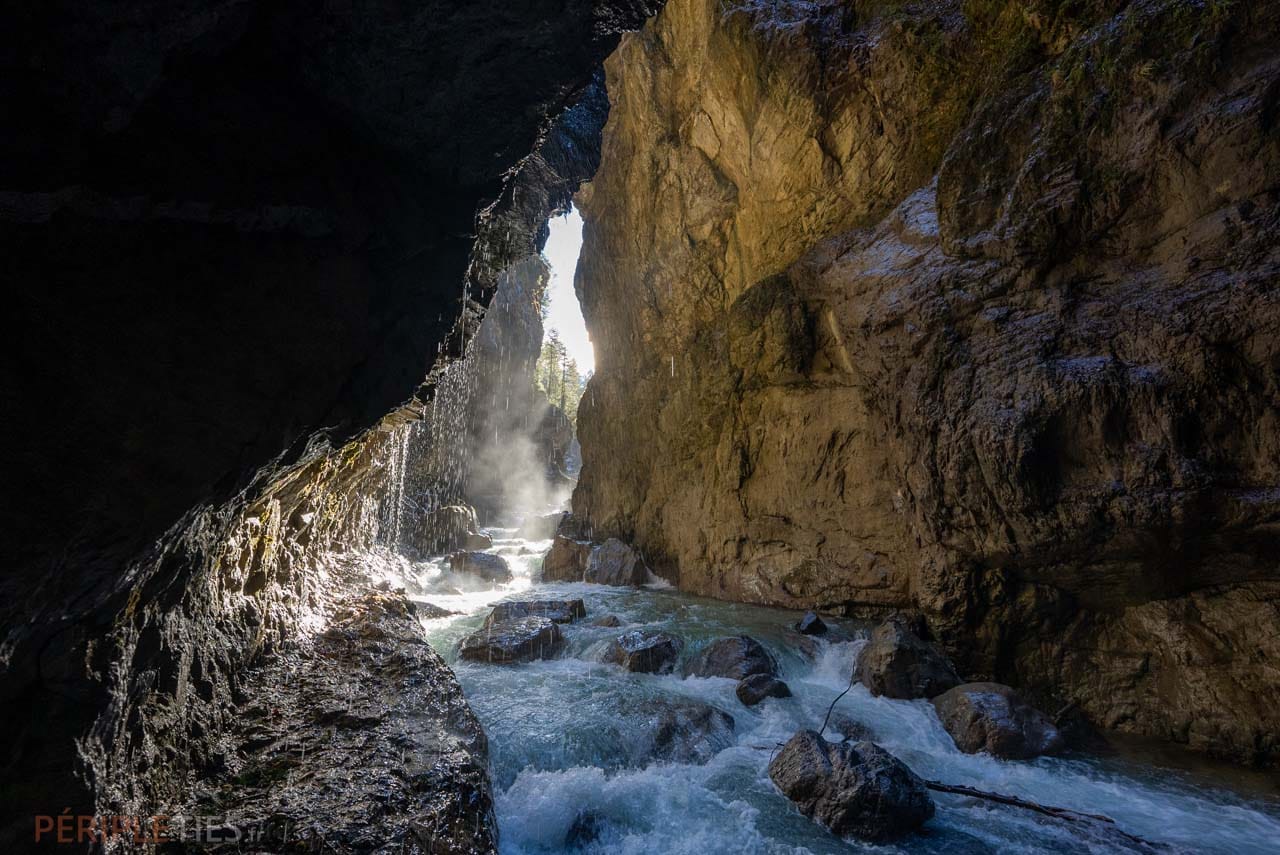
It's an unforgettable experience, especially in winter, when stalactites form on the rock. However, this is a very popular spot and can get crowded.
You can sometimes walk in single file through the gorges, which can be a bit inconvenient if you have to turn back (the paths may be closed in bad weather).
But as a general rule, you can hike throughout the park once you've paid the fee.
👉 Our advice: arrive early in the morning and outside the tourist season to avoid the crowds.
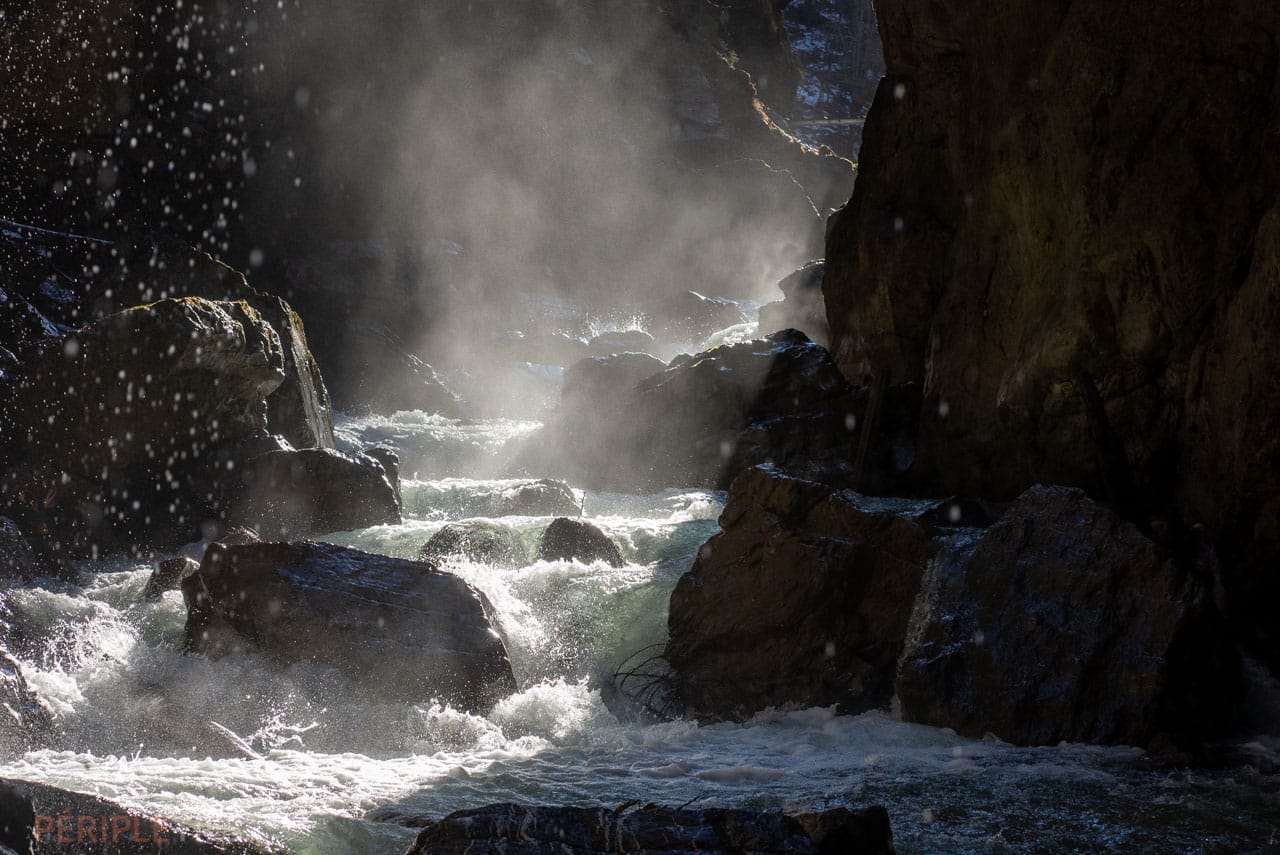
Other useful information: access to the gorges is subject to a fee of €7.50 per adult (I know, from a French point of view, it's a bit odd, but let's look at it as a way of preserving the site. We hope, however, that we'll never be forced to do this everywhere in order to preserve our natural wonders).
Day 5: Visit to Ettal Abbey
Just a few kilometres away, you'll find the incredible Ettal Abbey (not to be confused with its Belgian namesake Etalle, along the Semoy in Belgium), a Benedictine abbey founded in 1330 by Emperor Ludwig IV of Bavaria. It is famous for its magnificent Baroque church and monastic school.
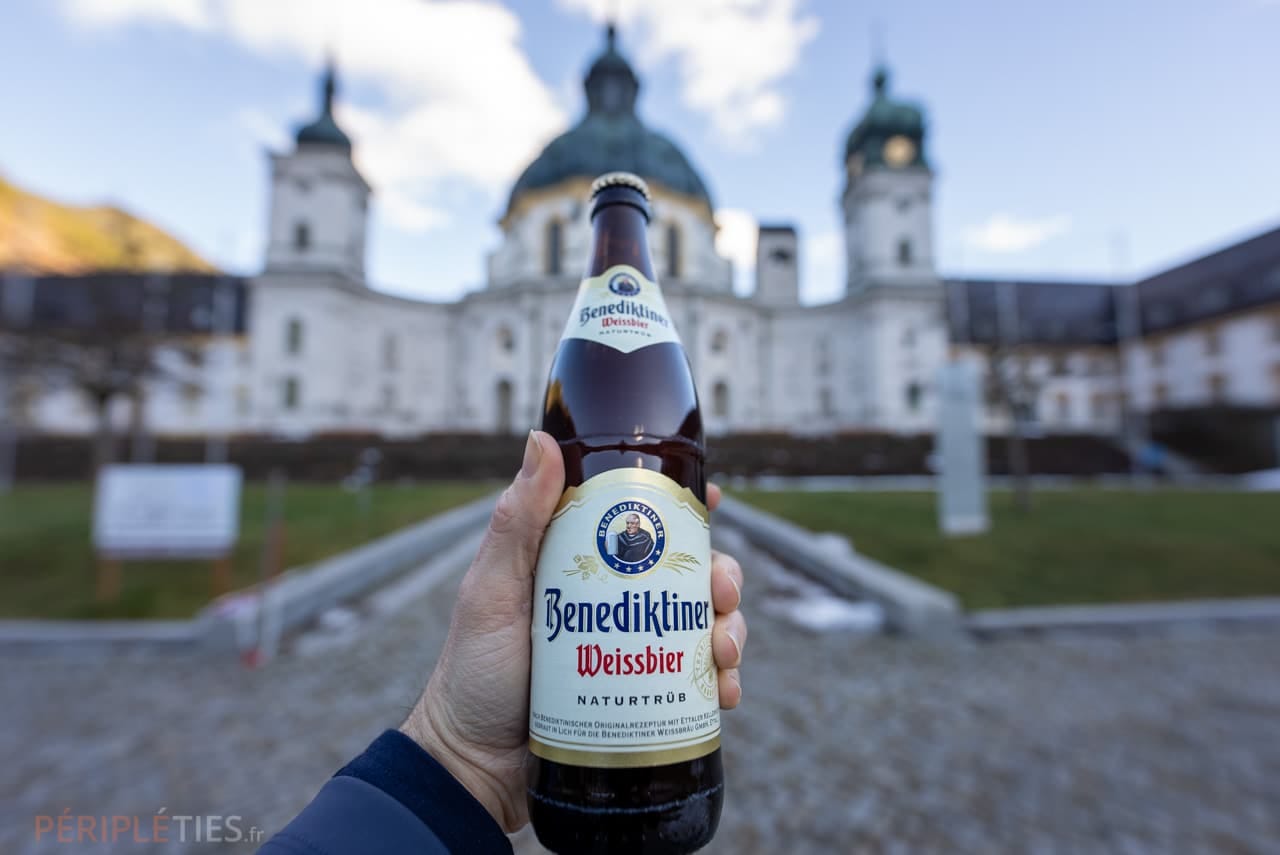
The visit is free, so we didn't hesitate to buy a few beers and a Bavarian mug, because I love that! (The mug!)
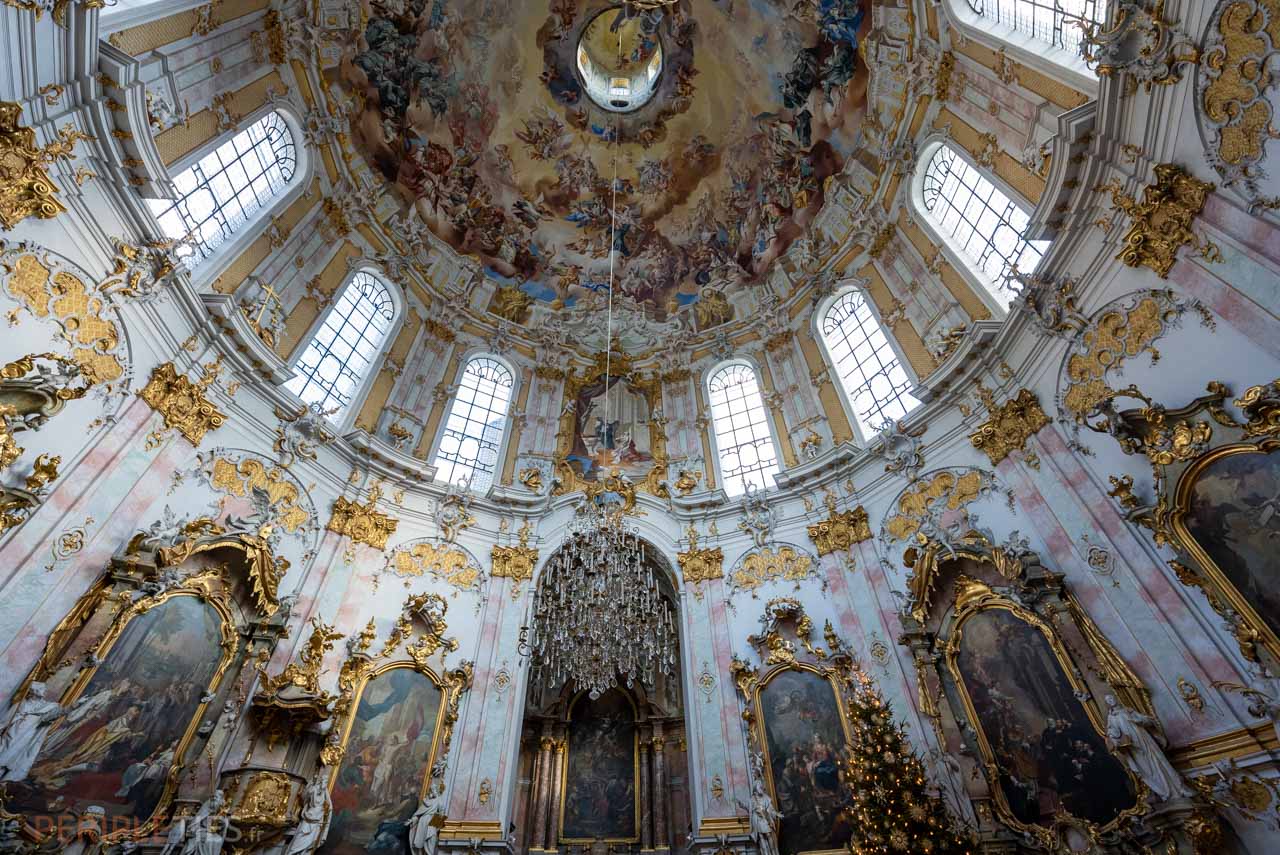
A stopover in Oberammergau
Our day ends in Oberammergau, a charming village famous for its traditional Passionsspiele (Passion Play), a monumental event that takes place every ten years and attracts visitors from all over the world!
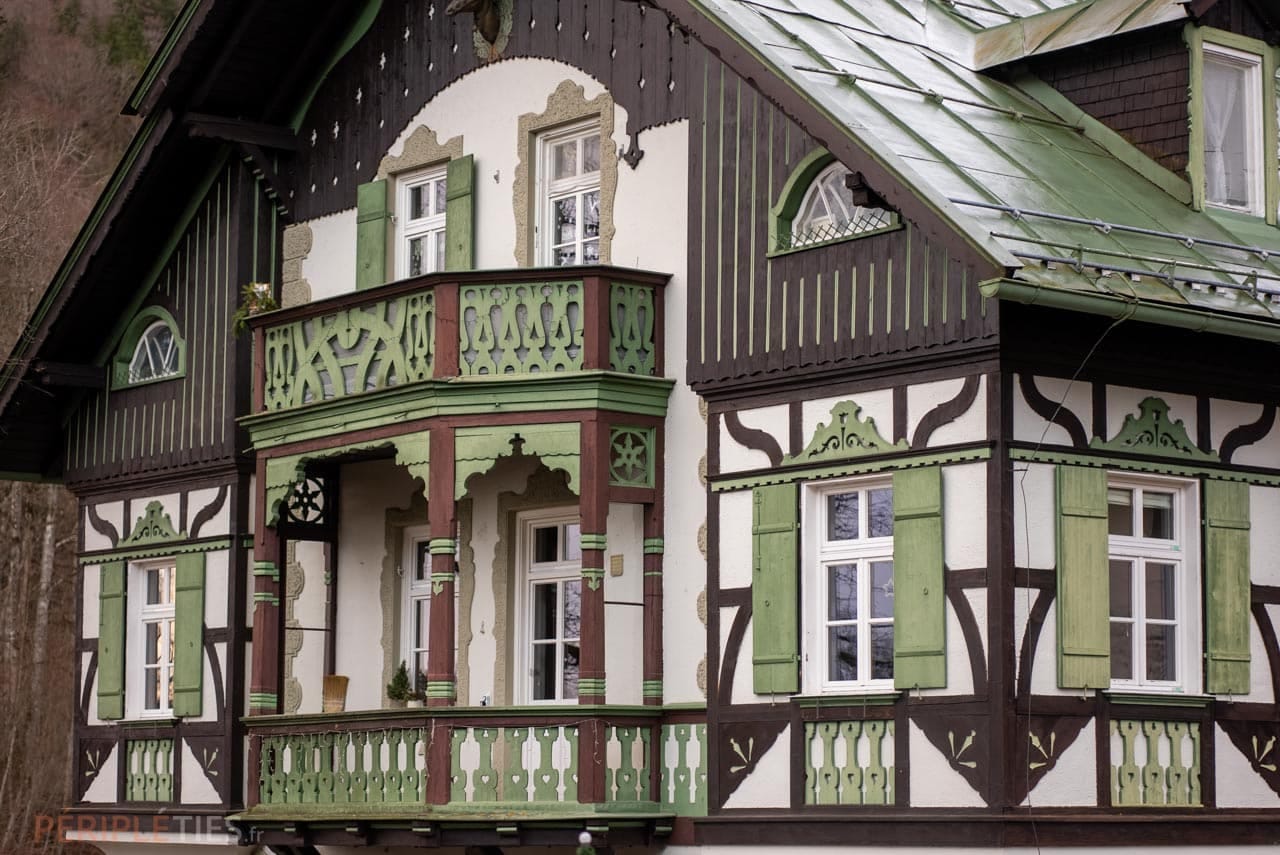
As you stroll through its streets, you'll be enchanted by the half-timbered houses and the murals, the ‘Lüftlmalerei’, which adorn many of the houses, telling biblical stories and traditional Bavarian scenes.
Oh yes, Oberammergau is also renowned for its crafts, particularly woodcarving and pottery!
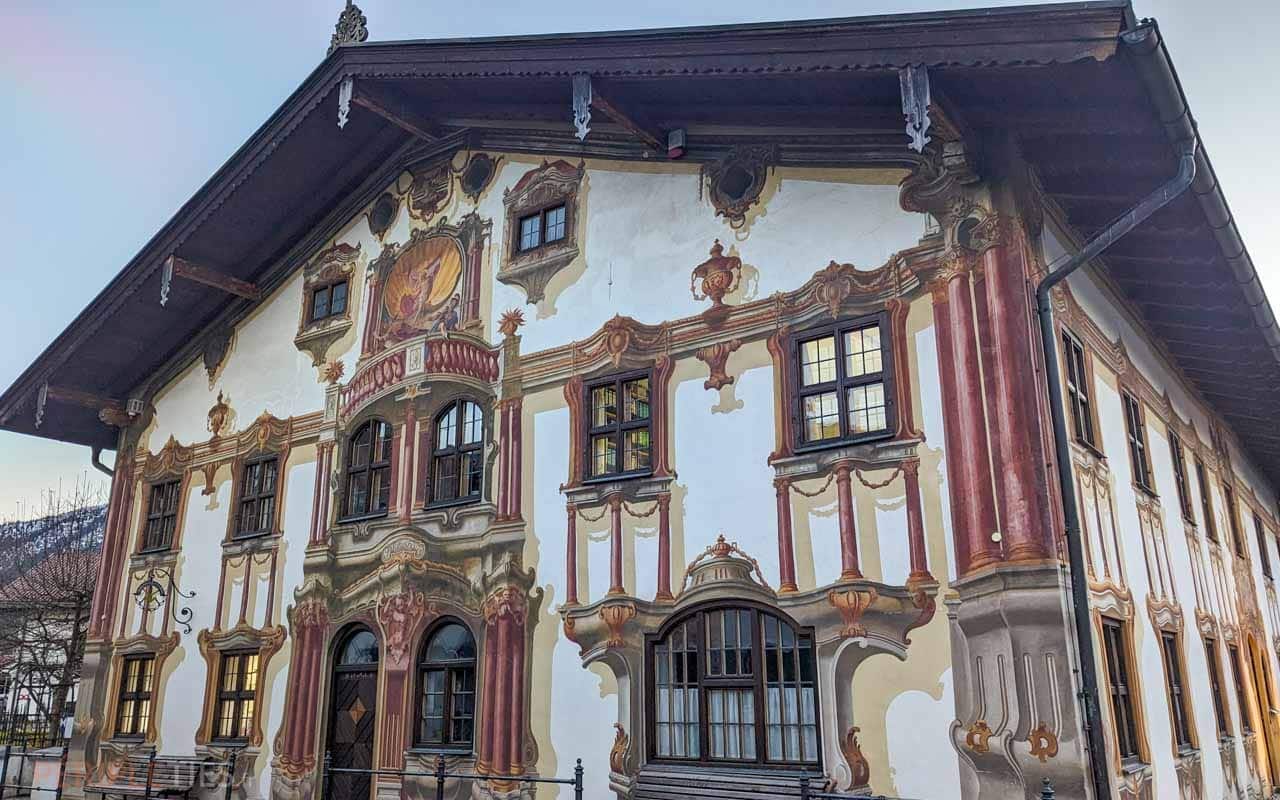
Day 6: Which castle to visit in Bavaria?
We've already mentioned it, but in Bavaria, one of the most famous and unmissable castles to visit is Neuschwanstein Castle in Füssen.
Before arriving there, our route took us to the first impressive structure.
An excursion to Linderhof Palace
Another of King Ludwig II's ‘fantasies’, Linderhof Castle is smaller but just as impressive.
It's a sort of miniature Versailles, with all the rarest and most luxurious rooms, materials and objects from all over the world. Spoiler alert: it's packed, very packed!
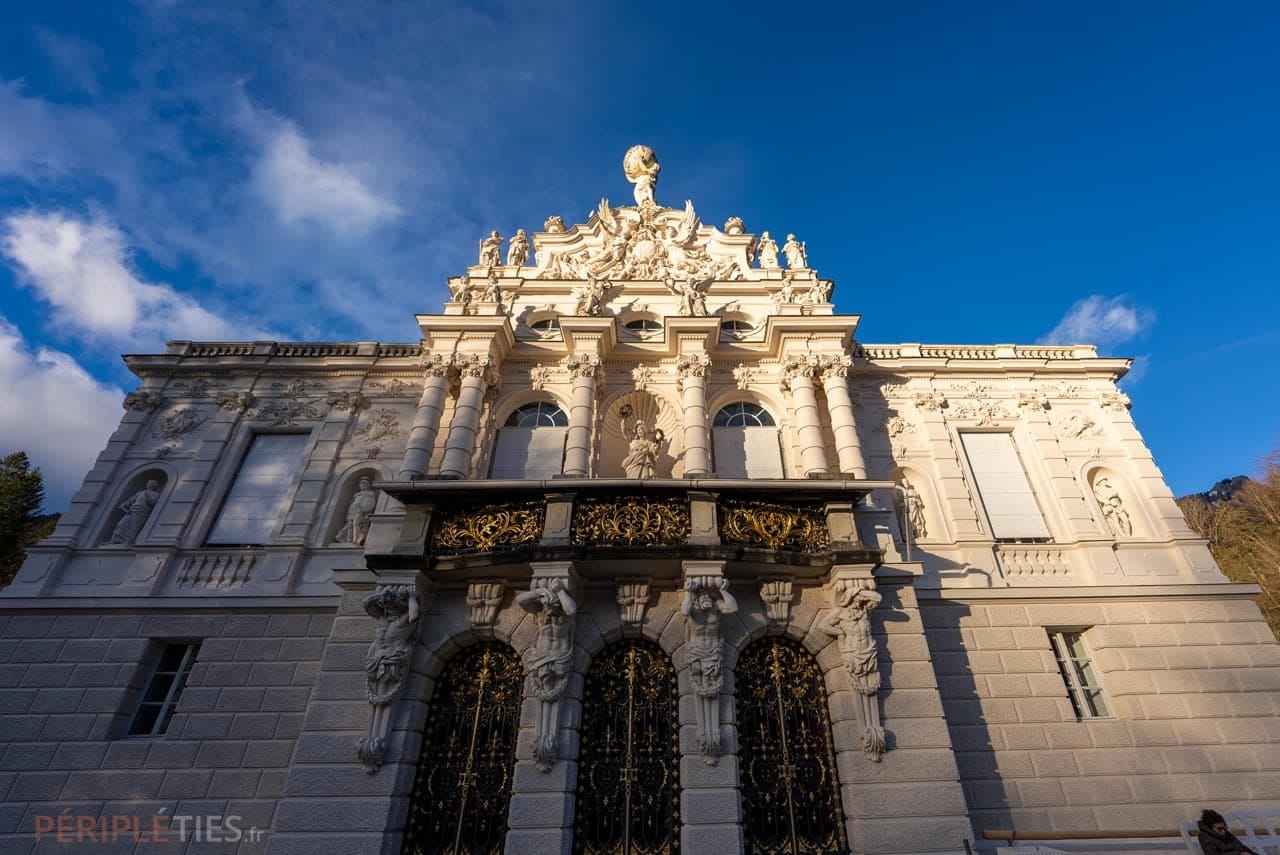
A guided tour on the double
We took a guided tour on the double (20 minutes, watch in hand) with an audio guide giving brief explanations in Spanish for all the guests. As we were the only French speakers, we had a booklet in French. So much the better, as it allowed us to take just a little more time.
At the end, no questions asked, move along! In short, although I liked the place, the visit was decidedly not great!
The gardens: a little Versailles closed in winter
The gardens are also magnificently laid out, but unfortunately in winter half of the infrastructure is frost-free, including the incredible fountain. In any case, the estate is undergoing works until at least 2026 (which they are careful not to tell you when you enter).
How much does Linderhof cost?
Admission to Linderhof Castle is €8.50 for the palace and the garden structures. In winter, when only the palace is open, the price is €7.50.
As detail-oriented visitors, we can't help pointing out these two somewhat disappointing aspects (I think it's French to grumble?!).
Anyway, if your time or budget is limited and you have to choose just one castle to visit in Bavaria, we'd recommend Neuschwanstein Castle.
Day 7: Visit to Neuschwanstein Castle
We're off to Füssen to visit the famous fairytale castle. Neuschwanstein Castle is said to have been the inspiration for Walt Disney's Sleeping Beauty.
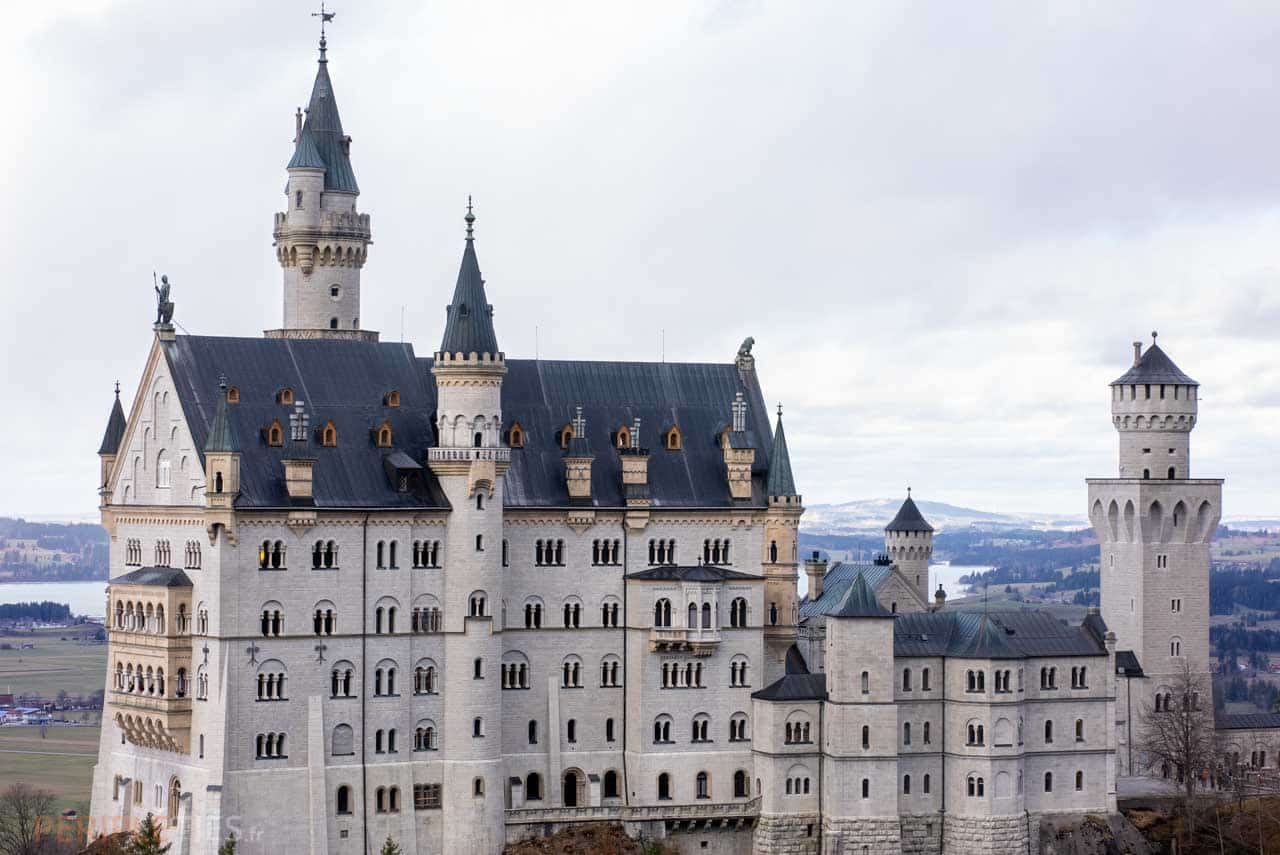
A fairytale castle
Its silhouette can certainly be made out on the distant horizon. Built by King Ludwig II of Bavaria in the 19th century, Neuschwanstein is famous for its romantic architecture and its absolutely incredible location in the heart of the Bavarian Alps.
The castle's interior is just as impressive, with rooms adorned with murals depicting scenes from Germanic legends and myths, a throne room inspired by Byzantine cathedrals, a romantic grotto in the castle grounds...
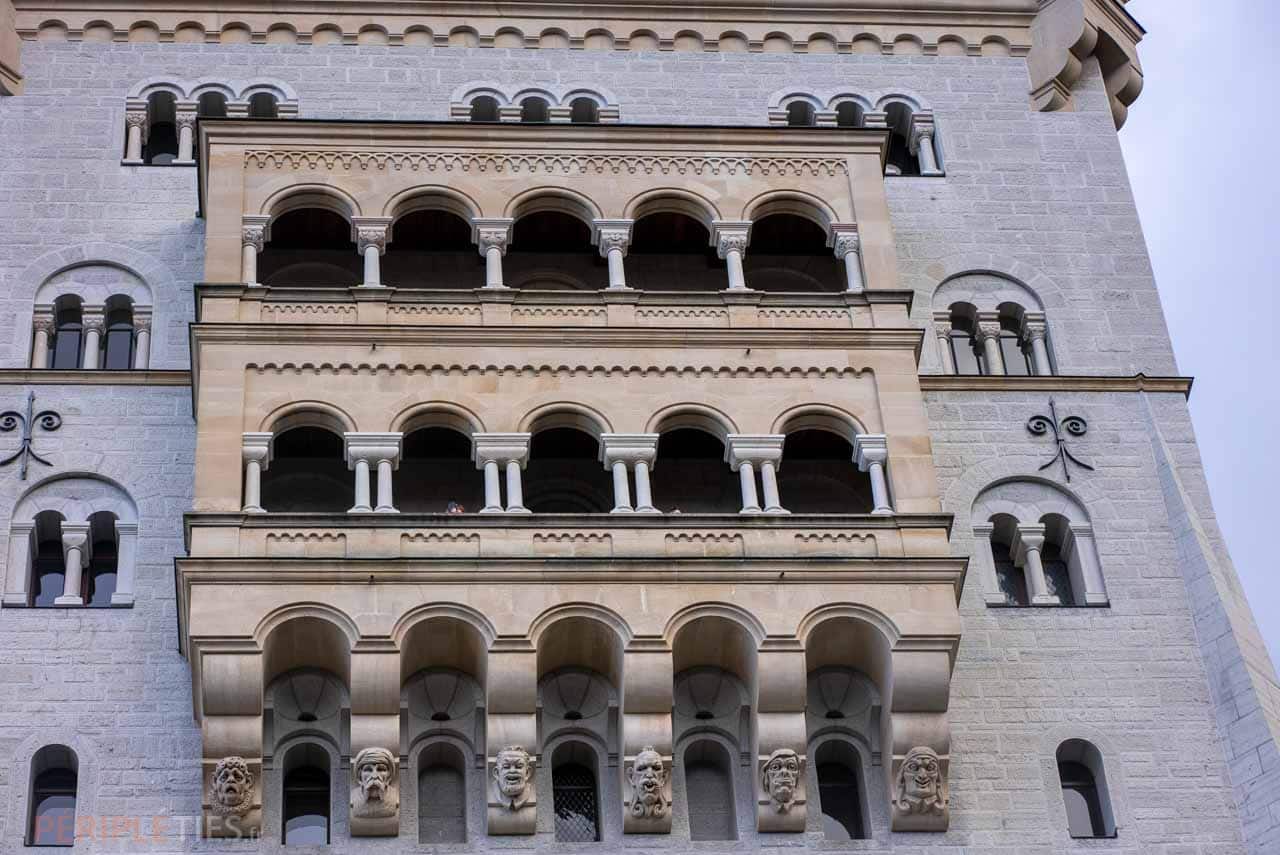
It is also, for its time, a maze of modern technology, with an ingenious central heating system, running water and even a bell system to summon servants.
How much does a visit to Neuschwanstein Castle cost?
An emblematic symbol of Germany, Neuschwanstein attracts millions of visitors every year. The castle can be reached by road (or footpath in summer), by shuttle bus or by foot from the car parks further down the valley.
The tour is also very carefully planned, but better orchestrated than that of Linderhof. Here again, we would advise you to visit early in the morning.
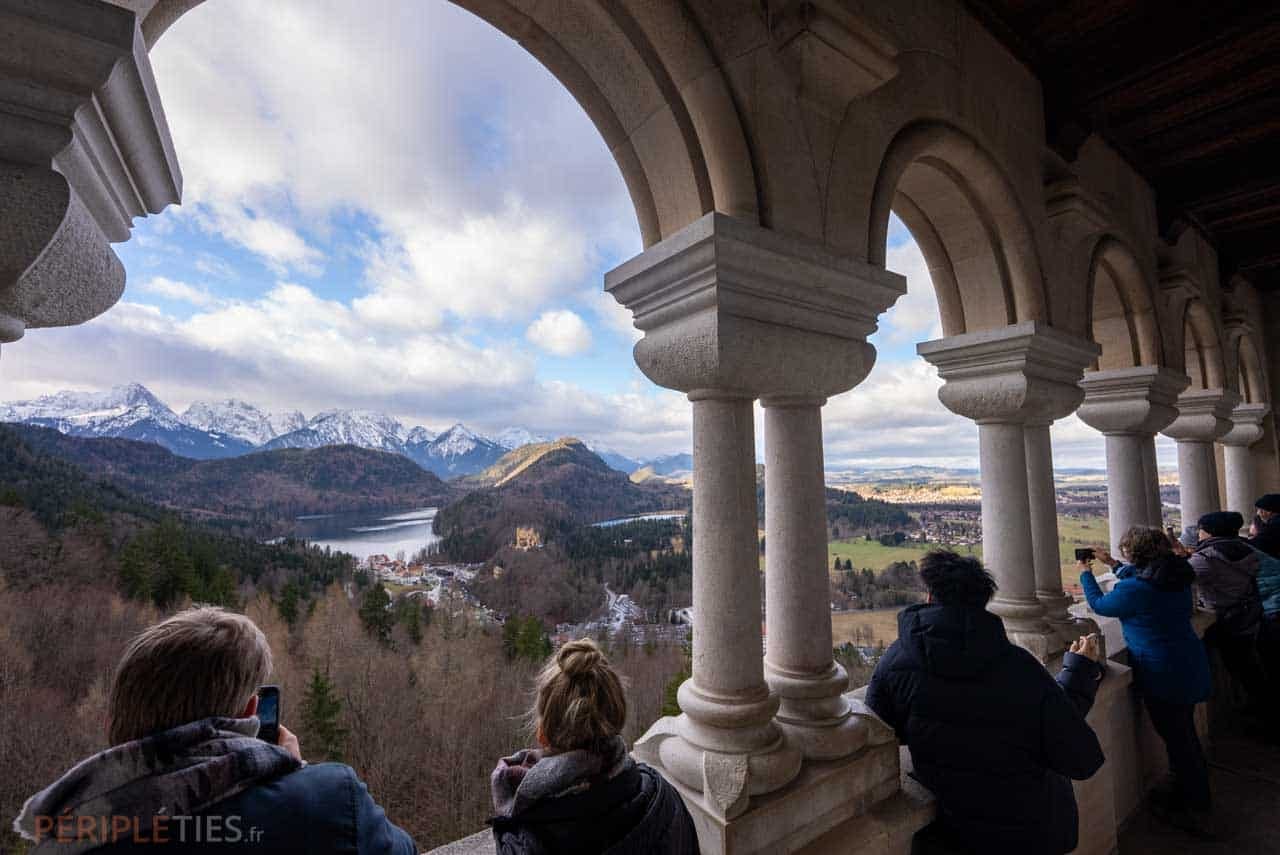
The price per adult is €18 (€20.50 online). And if the official website no longer has any tickets available, you should know that you can often get tickets at the ticket office! When we booked our hotel near Neuschwanstein Castle, no tickets had been available online for over a month. We tried on site that morning and there were still a few slots available.
How do you book tickets online, at the venue or with a ticket?
The other solution if you run out of places is to look at online activity sites such as GetYourGuide or Tiqets, which may also have places left.
Of course, you'll pay more, but the ticket price includes direct, unaccompanied entry to Neuschwanstein Castle, a 35-minute guided tour by an official guide, and a visit to the Marienbrücke bridge.
How to get a view of Neuschwanstein Castle (Marienbrücke)
Looking for a great photo or selfie with Neuschwanstein Castle in the background? Then it's time to step back and take a walk. Whether you've come on foot or by shuttle bus, head for the bridge over the River Pollat, called Marienbrücke in German or Queen Mary's Bridge in English (5-10 mins). Once you reach the bridge, beware of vertigo! As the bridge is a well-known tourist thoroughfare, you'll need to take a deep breath 😊
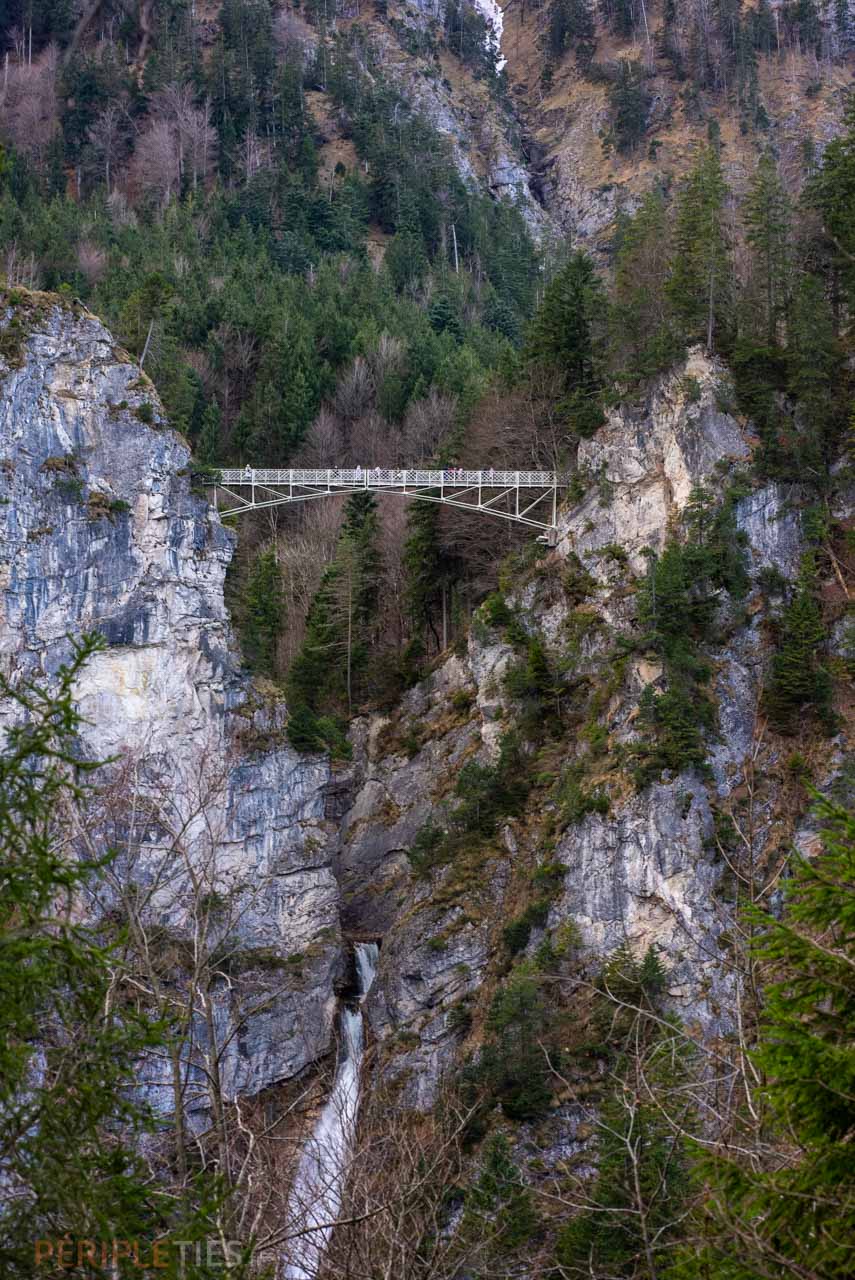
But the view of the castle and the gorge is splendid! Cross the point and continue along the waymarked path to reach a second viewpoint. Allow 7 km round trip and 370 m ascent + to reach the best viewpoint (the third)! And for the more motivated and athletic, there's a long climb up to Mount Tegelberg, with its many panoramic views. You can then take the cable car back down (for a fee).
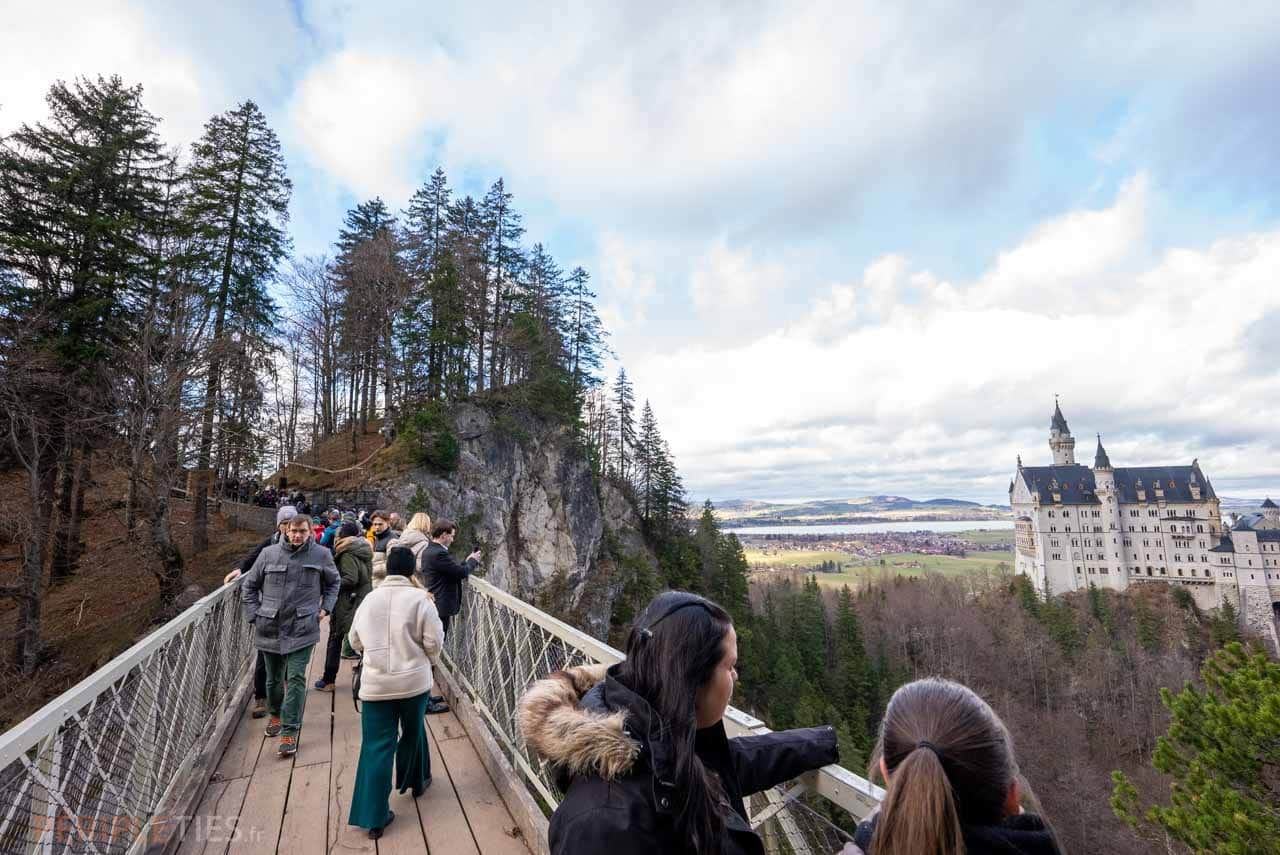
Hohenschwangau Castle
Facing Neuschwanstein, Hohenschwangau Castle is where Ludwig II spent much of his childhood.
Less well known but rich in history, its octagonal architecture is more reminiscent of an Aragonese castle. It costs around 20 euros, and combined tickets are sometimes available. The excursion from Munich includes both castles.
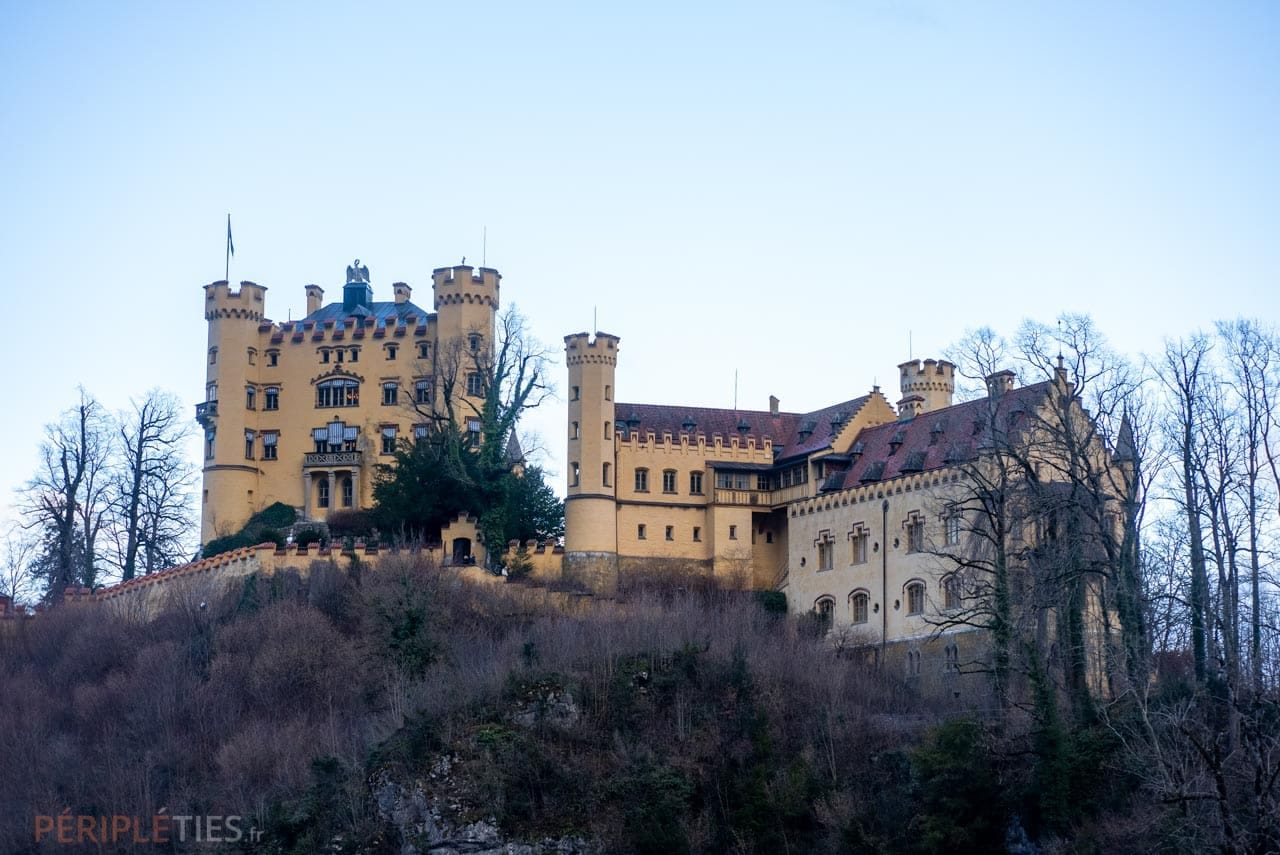
Extending our trip to Bavaria
Our first trip to Bavaria ends here, but it's made us want to extend it on future summer excursions.
We thought it would be a good idea to visit places further east like Hitler's Eagle's Nest, such as Lake Chiemsee, which also houses a Ludwig II castle, Herrenchiemsee Castle on the island of Herreninsel, and continue on to Austria.
This time, we returned to France via Constance and the Black Forest region (we'll be publishing an article on this blog shortly).
Hitler's Eagle's Nest (Kehlsteinhaus)
The Eagle's Nest, also known as the Kehlsteinhaus, is a pavilion at the top of the Kehlstein mountain near Berchtesgaden, Germany. Built as a birthday present for Adolf Hitler, it served as a venue for receptions and meetings for the Nazi party. Today, this historic site offers spectacular panoramic views of the Bavarian Alps. We weren't able to visit it, as it is closed in winter (1834 m) and won't reopen until May 2024.
The Romantic Road from Füssen to Würzburg
From Füssen, you can also follow the Romantic Road (Romantische Straße), a famous tourist route through natural landscapes straddling Bavaria and Baden-Württemberg.
Ideal for a road-trip, it stretches for around 350 kilometres to Würzburg, passing through medieval towns such as Rothenburg ob der Tauber, Dinkelsbühl and Augsburg, which are outstanding examples of the region's history and architecture.
Wiblingen monastery and library
The region is home to castles, palaces and cloisters, such as the incredible Wiblingen Monastery, which we had the opportunity to visit and which, with its rococo-style library, is a surprising discovery!
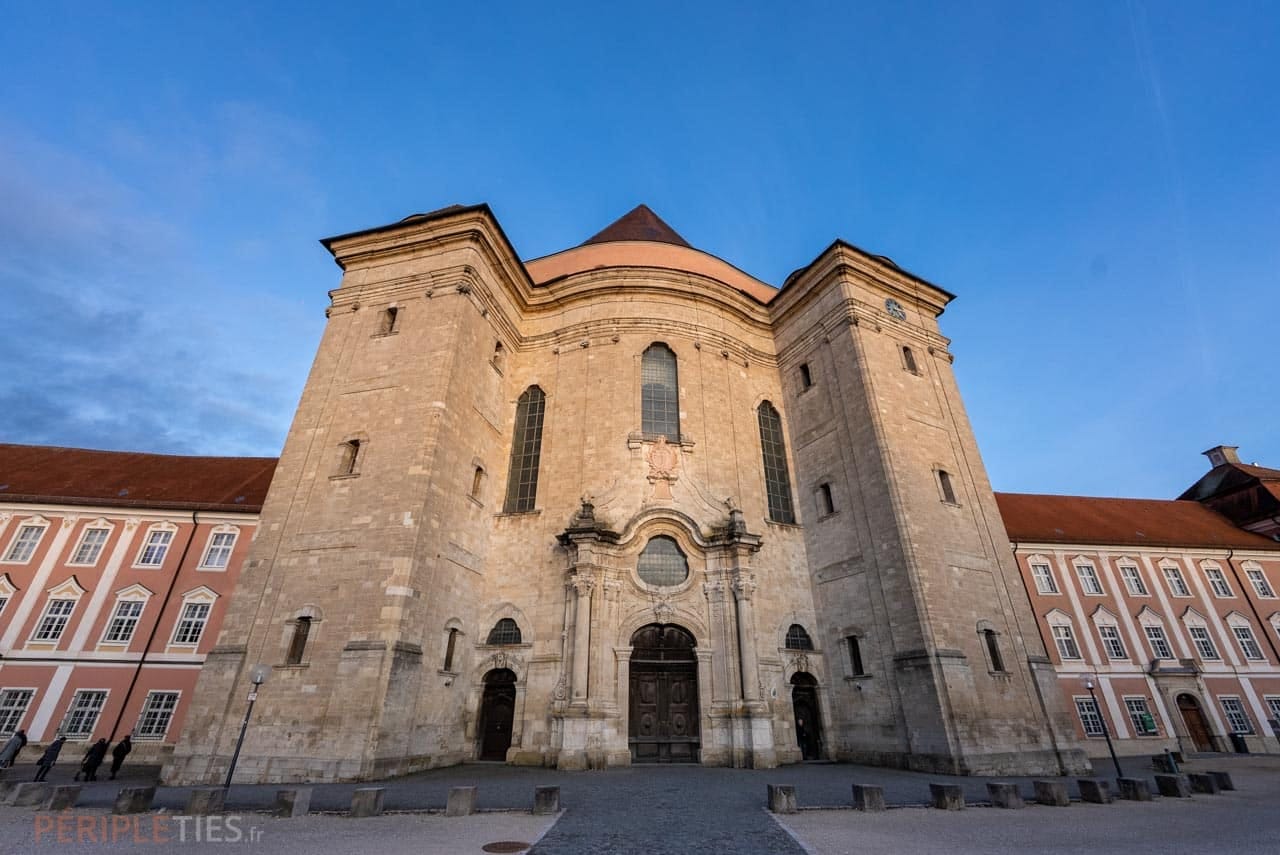
It is not known whether it is considered to be part of the Romantic Road, but it is in any case located near Ulm.
Several sites along the route are UNESCO World Heritage Sites, including the Würzburg Residence.
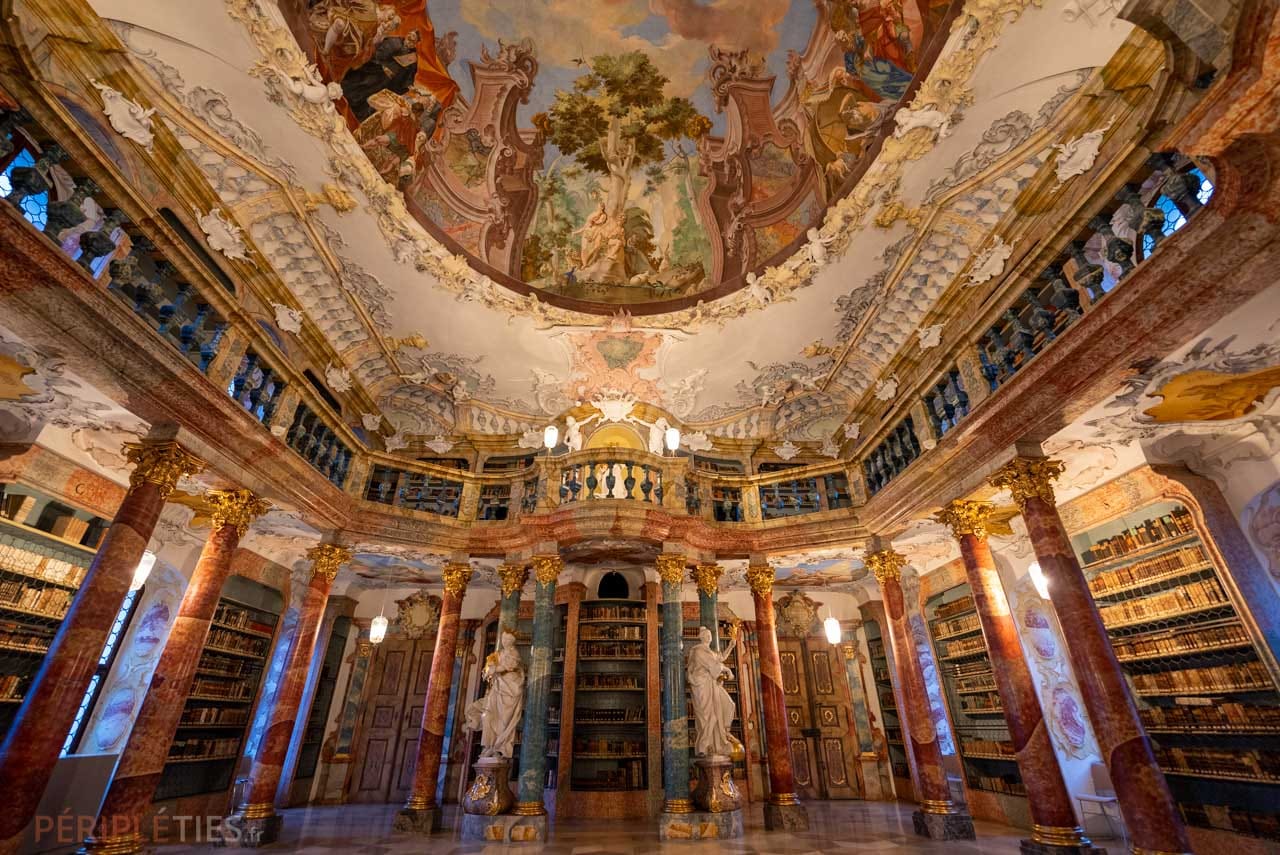
Getting around Bavaria
By car
If you want to explore Bavaria at your own pace and visit more remote areas, car hire is an excellent choice. The main car rental agencies are available in Munich, at airports and in Bavaria's major cities.
Public transport
The German railways (Deutsche Bahn) offer an excellent network of regional and intercity trains in Bavaria. You can use the trains to connect major cities such as Munich, Nuremberg, Augsburg and many others. Trams, underground trains and buses are practical ways of getting around. Munich, for example, has a highly efficient public transport network.
Motorhome parking areas in southern Bavaria
- Camping Munich: Campingplatz Nord-West, €32/night (plus electricity and shower). Connections to Munich city centre by bus and underground. N 48° 11′ 22.39″ / E 11° 29′ 48.33″
- Bad Tölz car park: Open all year, €16/24h, water €1/30l. 10 min walk from town, cycle path along the Isar. N 47°45'48.2184’ E 11°32'58.5132’
- Garmisch-Partenkirchen car park: Terrace car park with tarmac parking spaces. 23/night + tourist tax of €3 per person.
- Camping-park near the town of Oberammergau: €26/night service included. N 47°35'24.3564‘ E 11°4'9.48’.
- Neuschwanstein Castle: Designated car park (P1 to P4) with a view of the castle. ‘Alpseestrasse, Hohenschwangau. 24-hour motorhome rate: €10.00.
Bon Voyage! 😉
Pauline & Simon
